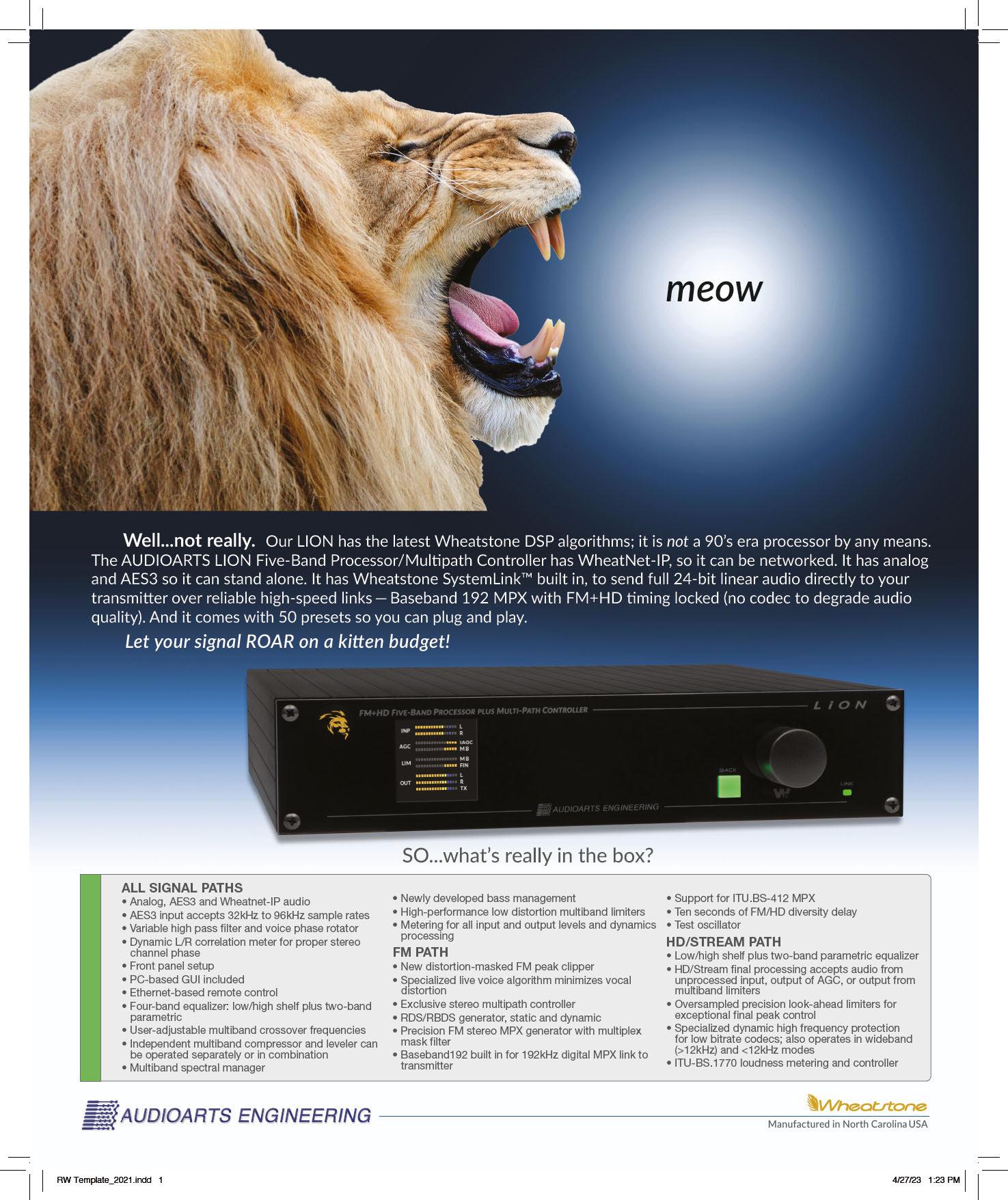

Make Your Streams Stand Out

Stream up to eight programs at once, each with four outputs for a total of 32 streams. Full suite of stream-specific audio processing tools. Optimize performance of audio content.
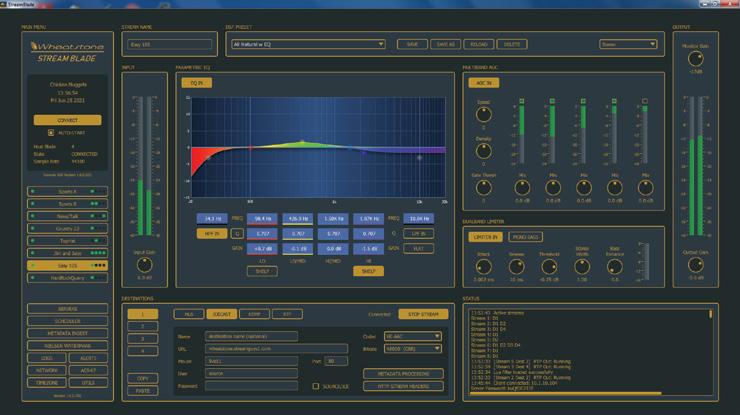
AAC, MP3 and Opus encoders. Reaching a broad range of end user devices and players.

Metadata agnostic. Lua transformation filters adapt metadata input from any automation system into any required output format.
Cloud-ready for the future, yet compatible with standard CDN and streaming platforms now. Supports HLS, Icecast, RTMP, and RTP streams.
All-inclusive Linux and AoIP appliance. No Windows® drivers, updates or PC needed. Add Streamblade to any audio network via WheatNet-IP, analog, AES3, or AES67 inputs or add Wheatstream to any existing WheatNet-IP or AES67 compatible networks.

wheatstone.com/stream-rw21a



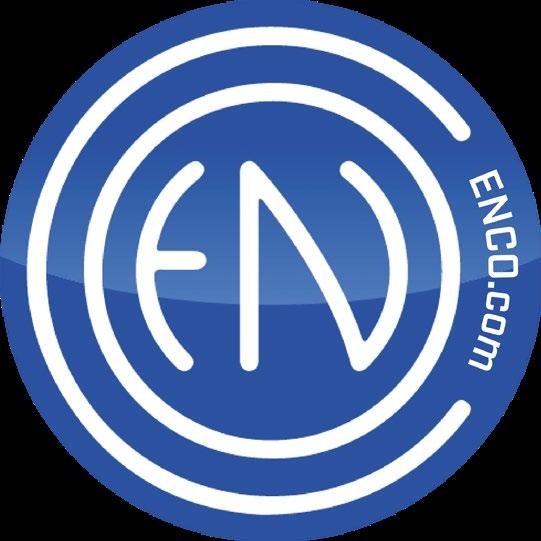

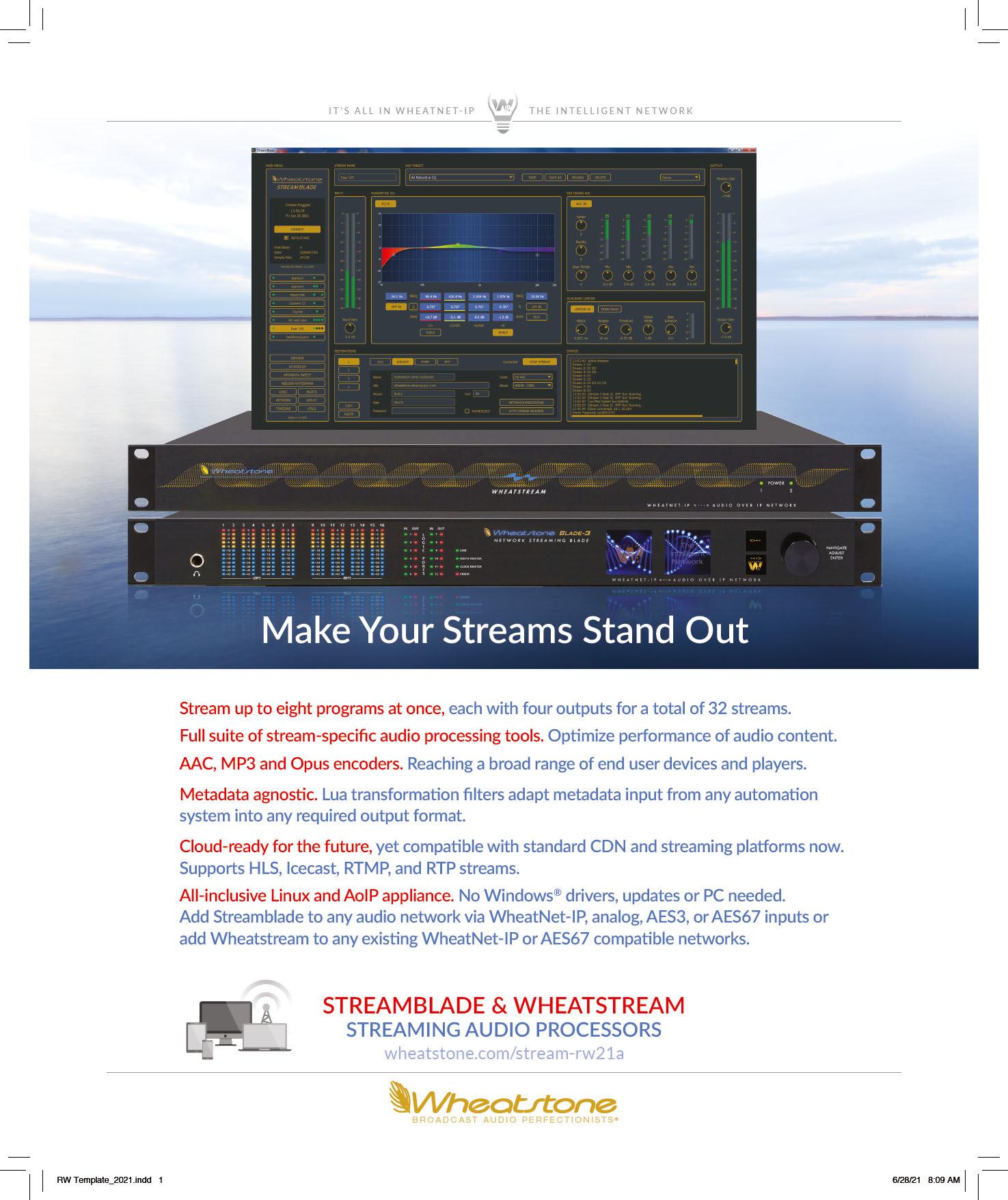
Future’s 2022 B2B Publication of the Year
Vol.
|
FOLLOW US
www.twitter.com/radioworld_news
www.facebook.com/RadioWorldMagazine
CONTENT
Managing Director, Content & Editor in Chief Paul J. McLane, paul.mclane@futurenet.com, 845-414-6105
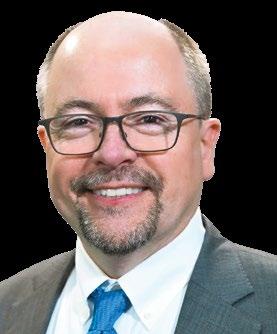
Content Producer & SmartBrief Editor Elle Kehres, elle.kehres@futurenet.com
Technical Advisors Thomas R. McGinley, Doug Irwin
Technical Editor, RW Engineering Extra W.C. “Cris” Alexander
Contributors: Susan Ashworth, David Bialik, John Bisset, Edwin Bukont, James Careless, Ken Deutsch, Mark Durenberger, Charles Fitch, Donna Halper, Alan Jurison, Paul Kaminski, John Kean, Larry Langford, Mark Lapidus, Michael LeClair, Frank McCoy, Jim Peck, Mark Persons, Stephen M. Poole, James O’Neal, T. Carter Ross, John Schneider, Dan Slentz, Dennis Sloatman, Randy Stine, Tom Vernon, Jennifer Waits, Steve Walker, Chris Wygal
Production Manager Nicole Schilling
Group Art Director Nicole Cobban
Senior Design Director Lisa McIntosh
Senior Art Editor Will Shum
ADVERTISING SALES
Senior Business Director & Publisher, Radio World John Casey, john.casey@futurenet.com, 845-678-3839
Publisher, Radio World International
Raffaella Calabrese, raffaella.calabrese@futurenet.com, +39-320-891-1938
SUBSCRIBER CUSTOMER SERVICE
To subscribe, change your address, or check on your current account status, go to www.radioworld.com and click on Subscribe, email futureplc@computerfulfillment.com, call 888-266-5828, or write P.O. Box 1051, Lowell, MA 01853. Licensing/Reprints/Permissions
Radio World is available for licensing. Contact the Licensing team to discuss partnership opportunities. Head of Print Licensing Rachel Shaw licensing@futurenet.com
MANAGEMENT
SVP Wealth, B2B and Events Sarah Rees
Managing Director, B2B Tech & Entertainment Brands Carmel King
Managing Vice President of Sales, B2B Tech Adam Goldstein
Head of Production US & UK Mark Constance
Head of Design Rodney Dive
FUTURE US, INC.
Future US LLC, 130 West 42nd Street, 7th Floor, New York, NY 10036
All contents ©Future US, Inc. or published under licence. All rights reserved. No part of this magazine may be used, stored, transmitted or reproduced in any way without the prior written permission of the publisher. Future Publishing Limited (company number 02008885) is registered in England and Wales. Registered office: Quay House, The Ambury, Bath BA1 1UA. All information contained in this publication is for information only and is, as far as we are aware, correct at the time of going to press. Future cannot accept any responsibility for errors or inaccuracies in such information. You are advised to contact manufacturers and retailers directly with regard to the price of products/services referred to in this publication. Apps and websites mentioned in this publication are not under our control. We are not responsible for their contents or any other changes or updates to them. This magazine is fully independent and not affiliated in any way with the companies mentioned herein.
If you submit material to us, you warrant that you own the material and/or have the necessary rights/ permissions to supply the material and you automatically grant Future and its licensees a licence to publish your submission in whole or in part in any/all issues and/or editions of publications, in any format published worldwide and on associated websites, social media channels and associated products. Any material you submit is sent at your own risk and, although every care is taken, neither Future nor its employees, agents, subcontractors or licensees shall be liable for loss or damage. We assume all unsolicited material is for publication unless otherwise stated, and reserve the right to edit, amend, adapt all submissions.
Radio World (ISSN: 0274-8541) is published bi-weekly with additional issues in February, April, June, August, October and December by Future US, Inc., 130 West 42nd Street, 7th Floor, New York, NY 10036. Phone: (978) 667-0352. Periodicals postage rates are paid at New York, NY and additional mailing offices.
Congress to the rescue?
Lawmakers propose an AM mandate, while Ford backs down, for now
O
Just in case you didn’t catch all of it:
On May 15, almost a quarter of the U.S. House of Representatives asked car manufacturers to keep AM radio in new vehicles. The lawmakers mentioned past federal loans and incentives that the car companies have received and also asked if the companies plan to charge for “subscription-like” access to free AM or FM.
Two days later a bipartisan group of senators and representatives introduced an “AM for Every Vehicle Act,” which would direct federal regulators to require carmakers to maintain free AM broadcast radio.
Rep. Josh Gottheimer was the first lawmaker, to my knowledge, to have raised this idea, but it has big-name sponsors including Sen. Ed Markey, a Democrat, and Sen. Ted Cruz, a Republican, along with a number of other influential lawmakers and at least half of the FCC including the chairwoman.
The car companies, through the Alliance for Automotive Innovation, objected. “Congress has never mandated radio features in vehicles ever before,” it wrote, calling the bill unnecessary.
“Whether or not AM radio is physically installed in vehicles in the future has no bearing on the various methods of delivering emergency communications that alert the public.”
The Consumer Technology Association mocked the idea, saying a mandate would be a “nonsensical and counterproductive move by the federal government. ... Today’s drivers don’t drive Model T’s, and today’s listeners do not listen to gramophones.”
On May 23, Ford’s CEO Jim Farley posted: “After speaking with policy leaders about the importance of AM broadcast radio as a part of the emergency alert system, we’ve decided to include it on all 2024 Ford and Lincoln vehicles.”
NAB said it hoped other carmakers would follow suit; Sen. Markey said the “AM for Every Vehicle Act” remains a priority.
If you don’t already get it, sign up for the Radio World SmartBrief by clicking “Subscribe” at radioworld.com
ur daily Radio World SmartBrief newsletter was dominated by the AM story line in May.THIS ISSUE
3 From the Editor
4 Newswatch
5 Ampers aims to connect radio and local communities
FEATURES
10 Workbench: Readers identify the WE-111C audio transformer
Best of Show Awards at NAB BUYER’S GUIDE 24 Apps for radio technology
OPINION
3
Regulatory Fees
U.S. radio stations would pay a bit less in regulatory fees this year under a plan released by the FCC in May. Stations in the smallest markets would get more substantial relief.
Broadcast groups including the NAB have been critical of how the commission apportions fees to industries it regulates. Before releasing planned fees for fiscal 2023, the FCC says it performed “a high-level, yet comprehensive, staff analysis of the work being performed by commission employees.”
While the notice of proposed rulemaking for FY23 does not incorporate many of the changes suggested by the NAB and others, the FCC did decide to reallocate some “indirect” FTEs, or full-time employee positions, as direct, which affects its fee calculations.
For radio, the upshot is a proposed schedule of fees that are lower than last year’s. For instance a Class B FM serving a population of a million people would pay $6,275, down from $6,630. An FM Class C in the largest markets would pay $21,190, down from $22,390.
But the FCC also proposes to split the lowest population tier for AM and FM broadcasters into two. So stations in the new smallest tier, in markets of under 10,000 people, would see bigger reductions in fees. A Class B AM station in a market of under 25,000 people would have paid $755 last year. Under this proposal, it would pay $430 if the population served was below 10,000, or $715 if the population was between 10,000 and 25,000.
For fiscal 2022, radio fees were finalized only in September and went up 7 to 8%, though less than originally proposed.
Comments are due June 14 and replies June 29. Refer to MD Dockets 22-301 and 23-159.
Spots on LPFM
A Colorado LPFM station was assessed a $15,000 fine by the FCC for airing commercials. The commission said KELS(LP) in Greeley aired more than 1,600 spots in just three months in 2018 and that the Enforcement Bureau had received complaints going back to at least 2015.
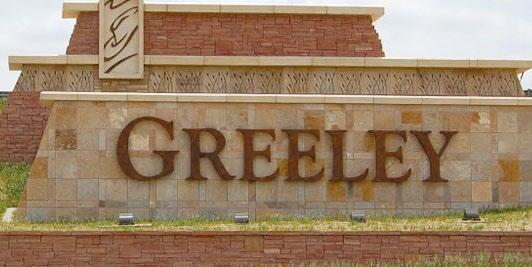

The FCC had issued a notice of apparent liability almost three years ago. Now it says licensee Plymouth Gathering Inc. didn’t dispute airing spots but asked for a reduction or elimination of the fine, saying it couldn’t afford to pay. The commission rejected its appeal.
The Enforcement Bureau said the base fine of $2,000 in such cases was increased to $15,000 because of “the protracted period of time over which the prohibited announcements were aired, the number of announcements at issue as well as forfeiture actions in other underwriting cases.”
Ampers aims to connect radio & underserved communities
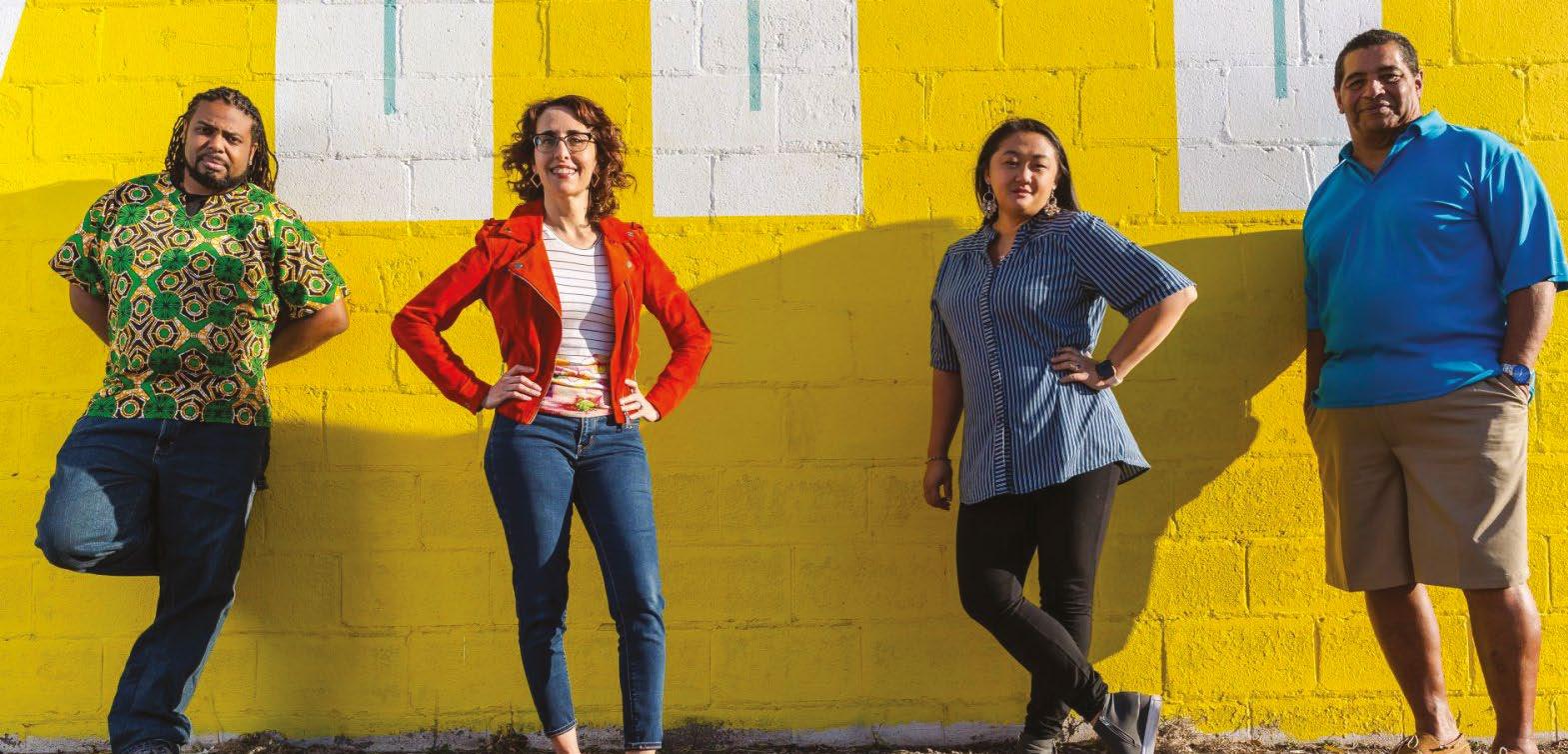
Minnesota-based organization programs to listeners not served by traditional media
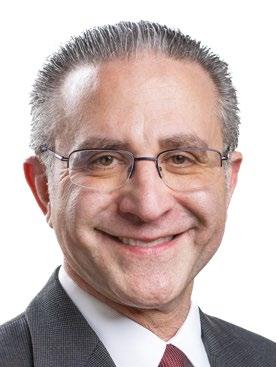

Ampers is on the move. The Minnesotabased collection of 18 independent community stations is working to expand its services.
The Association of Minnesota Public Educational Radio Stations is a nonprofit support organization whose member stations focus largely on small and underserved communities. These full-power, non-commercial outlets, mostly FMs, include music formats from classic rock deep tracks to jazz and blues, along with cultural programming aimed at people across the North Star State.
Four of its stations are licensed to Native American communities. One member station has programming in 10 languages; another is the only station in the state with a mission to serve communities of color. Additional areas of focus include the needs of Minnesota’s rural residents and its new immigrants.
50 years and counting
Ampers is the largest association of its kind in the country and represents
most of the public stations in the state that are not affiliated with Minnesota Public Radio.
“Stations are often run by volunteers and programmed by and for their specific community,” it states. In some areas these stations are the only local source for news, emergency alerts and information about forest fires, storms, road closures and evacuations.
The organization, with a staff of four full-time employees, announced two notable personnel moves recently, adding Hlee Lee-Kron as its vice president of programming and promoting Justus Sanchez to production director. They oversee a team of about 25 contract producers who create content.
Ampers was founded in 1972 as a not-for-profit organization with seven member stations. It is not affiliated with MPR nor does it receive financial support from it.
CEO Joel Glaser says Ampers was founded on a simple philosophy. “These community radio stations decided to incorporate and come together for the purpose to gain state support as a single entity instead of individual radio stations competing against each other for funding,” Glaser said, “and to help member stations better serve their communities.”
NXSeries
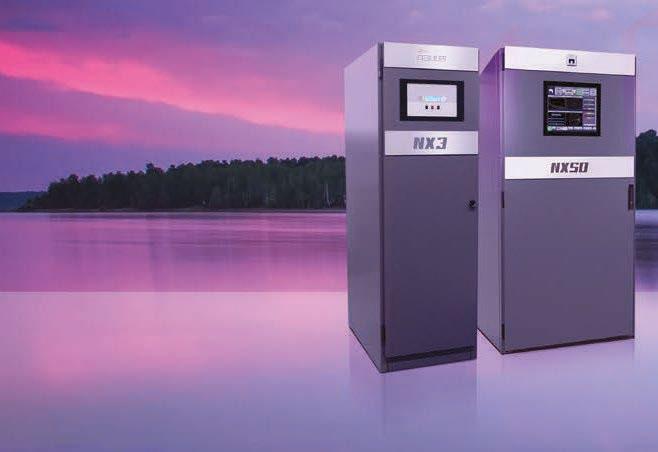
Where MPR might be compared to a big box store in that it serves large numbers of people around the state, Glaser said, “our stations are the corner drug stores and the corner hardware stores where everyone knows your name.”
Growing resources
Glaser, who joined Ampers in 2009, has three decades of broadcast experience including six years in advertising sales management with Hubbard Radio. He said obtaining state money for stations is just one of the pivotal roles Ampers fills.
“Helping them generate funding is obviously huge, but we also provide programming and staff training for members. We advocate for them. We lobby for them. We help them with legal issues and guide them with crisis management. Whatever it is our members need, we try to help with.”
Radio stations pay an annual fee, which helps fund the organization, but the stations “make back far more than they pay in yearly dues,” Glaser said. “It’s indeed well over ten-fold what members make back in grants, state funds and underwriting that we secure and share with the stations.”

Ampers is not just a radio network, Glaser says, but an association of stations, which means clients that provide underwriting can select which stations they want to be heard on. The group’s tagline is “diverse radio for Minnesota communities.”
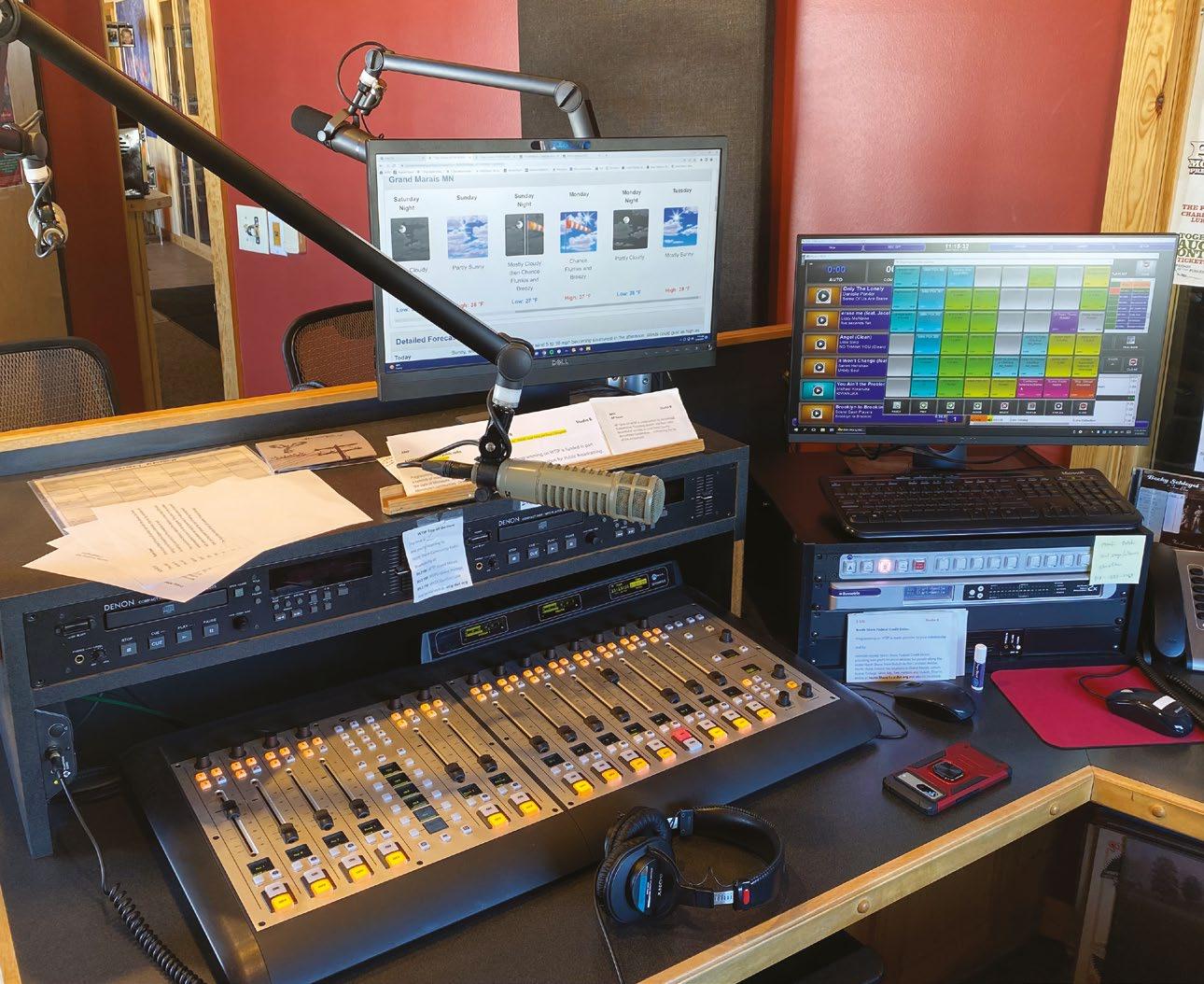
Funding comes from private donors, corporations, foundations and government agencies, he said, which is then disbursed to member stations.
Those resources have grown considerably. Fourteen years ago its annual revenue was around $300,000. In fiscal 2021 Ampers reported $1.7 million in total revenue. Membership dues accounted for approximately $100,000 of that.
Minnesota state appropriations to Ampers and its members in the fiscal years 2022 and ’23 totaled around $5.4 million. That was set to increase to $10.2 million for 2024 and ’25 in a bill the governor was expected to sign in late May. The increase of about $4.8 million is due to several initiatives including the launch of a diverse community radio news service.
Some of the organization’s affiliate stations also receive federal dollars from the Corporation for Public Broadcasting. Ampers includes a student-run station, KUMM(FM) in Morris, Minn., which is the only member that does not receive state funding because it doesn’t meet certain requirements.
Content creation
“At a time when other broadcast companies around the state and country are struggling and making cuts,” Glaser said, “our past two years have been two of our strongest years ever. That’s due in part because the Department of Health has recognized the importance of using our stations to reach the diverse underserved communities not reached through traditional media for the COVID outreach. And because of the racial awakening we’ve seen in our country but especially here in Minnesota.”
The organization also benefitted from the creation in 2008 of the Clean Water Land and Legacy Amendment to the Minnesota state constitution, which increased the
 Above
A studio at member station WTIP(FM) in Grand Marais, Minn.
Right Hlee Lee-Kron
Above
A studio at member station WTIP(FM) in Grand Marais, Minn.
Right Hlee Lee-Kron
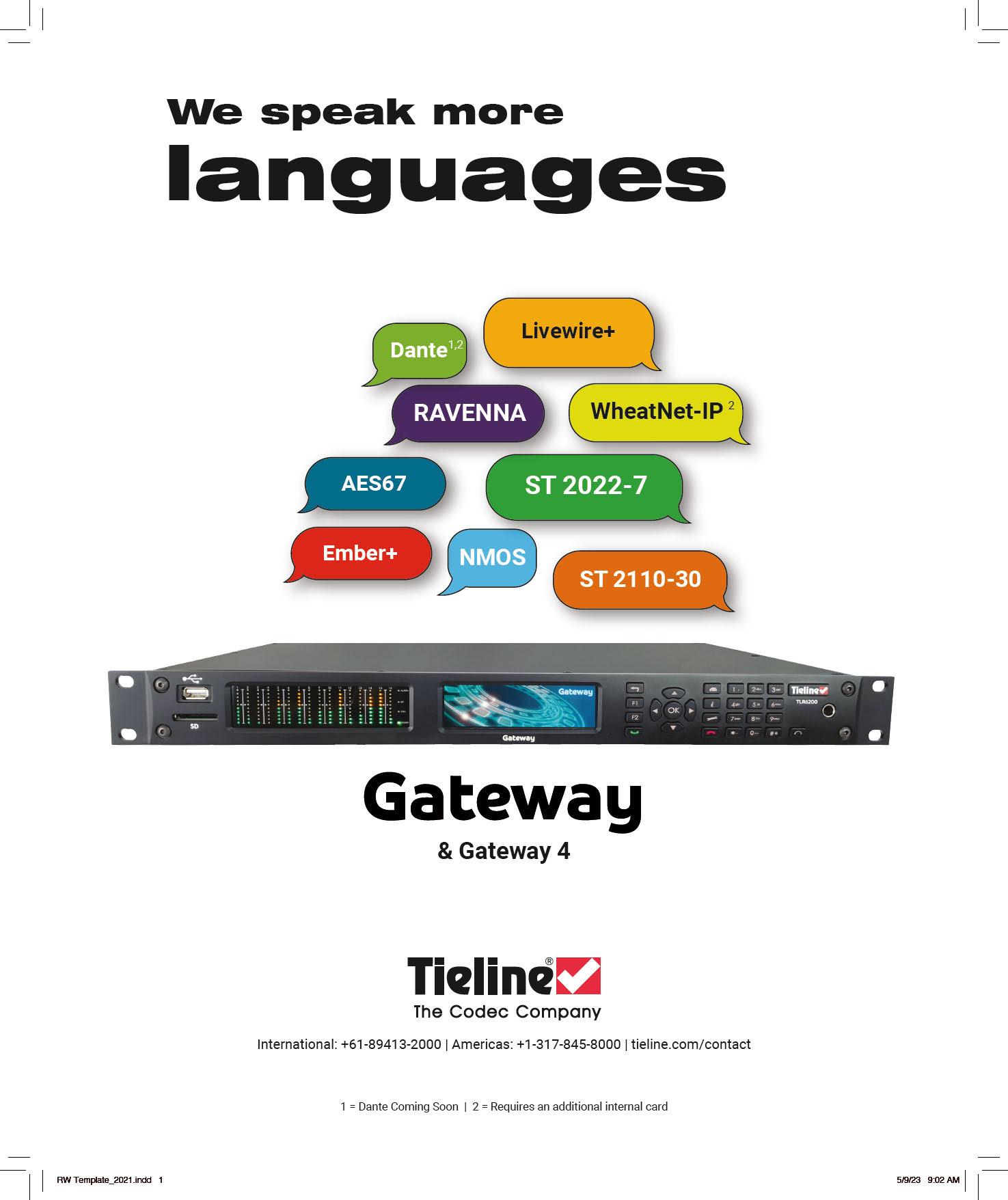
state sales tax by three-eighths of 1 percent. Those monies are designated for clean water projects, recreation and legacy projects, defined in the amendment as “art, culture and history,” which includes libraries, museums and public broadcasting.
“That was a substantial move forward for Ampers, as long as the content created by us with those funds is artistic and cultural about Minnesota and supplement regular programming and operations with new initiatives. We have used Legacy funding to create things like ‘Minnesota Native News,’ ‘Minnesota Music Notes’ and ‘MN90: Minnesota History in 90 Seconds.’ Some of that programming is customized to local markets.”
The pending state funding for fiscal 2024 and ‘25 mentioned above would include $4.1 million from the Legacy Fund.
“The programming we provide creates community conversations about things that really connect. We often find everyday people for storytelling about their own personal experiences. This initiative has grown into a lot of different health topics to create 90-second vignettes that air on the Ampers stations,” Glaser said.
Glaser points to the success of heart health and diabetes prevention and education campaigns that focus on peer-topeer messages.
The organization also received approximately $700,000 from the Minnesota Department of Health during the pandemic for educational outreach to diverse communities, according to financial filings.
Ampers has been recognized for its cultural programming, including its podcast series “Racial Reckoning: The Arc of Justice,” produced with KMOJ(FM) in Minneapolis. The news podcast was aimed at “changing problematic racial narratives in mainstream news and helping the local community form educated opinions,” according to its website.
Above “Native Lights” is a weekly show and podcast, part of Ampers’ Minnesota Native News Division. Shown at the state fair are, from left, hosts Leah Lemm and Cole Premo with Minnesota Lt. Governor Peggy Flanagan.

Right Justus Sanchez
Ampers Audio Transport
Ampers uses several tools to deliver programming to its member stations, including an FTP site where audio is loaded and then extracted by tools like DJB Radio Spider and ingested into on-air automation systems.
According to Justus Sanchez, production director for Ampers, the stations also have direct download access to programming from Box.com and PRX Exchange. “Our

Last month, another Ampers station, WTIP(FM) in Grand Marais, won the prestigious Edward R. Murrow Award from the Radio Television Digital News Association in the “Excellence in Diversity, Equity and Inclusion” category for the series “It Happens Here: The Roots of Racial Inequity on the North Shore,” produced by Staci Drouillard.
Especially well received has been “Veterans’ Voices,” a radio series produced by Ampers that explores the knowledge, experience and leadership of Minnesota service members. It too was created with the help of the Legacy Fund resources.
Glaser also sought a special one-time $850,000 appropriation from the state for fiscal 2024 for emergency equipment, cybersecurity tools and broadcast technology for its members. The money would be used for items like backup transmitters and generators, new automation systems and tech upgrades for remote operation. He added that several of its stations were hit by ransomware attacks in 2022.
Ampers does not have production facilities because its team of producers and journalists work remote, Glaser said. They work collaboratively utilizing Box.com to host audio and edit files.
There’s room for Ampers to grow, Glaser said, including the possibility of adding more Native American stations. “There are several large southern Minnesota tribes and we have discussed helping them find a signal. There are limited opportunities for that, obviously, but they would be a natural fit for Ampers affiliation.”
To stream any of the Ampers stations and learn more about the organization visit www.ampers.org.
programs also appear in podcast feeds through Transistor and our website Ampers.org through an API that ports them directly from PRX Exchange.”
The contract producers and journalists use Adobe Audition, Hindenburg, Apple Logic Pro and Pro Tools to edit audio and programs. “We utilize Box.com to host all of our audio and edit files. For us it integrates and syncs well from user to user,” he said.
The organization teams with their stations to originate live broadcasts from the Minnesota State Fair each summer using an Axia iQ digital console “that really simplifies the remote setup,” Sanchez said.
Ampers also uses Shure SM7B mics when recording programs in community, he said, which are paired with Zoom PodTrak P8 or Behringer X18 mixer when recording content to be broadcast later.

Readers identify the WE-111C audio transformer
The BBC used similar devices to connect the studio to the transmitter John Bisset
CPBE
The author is in his 33rd year of writing Workbench. He handles western U.S. radio sales for the Telos Alliance and is a past recipient of the SBE’s Educator of the Year Award.
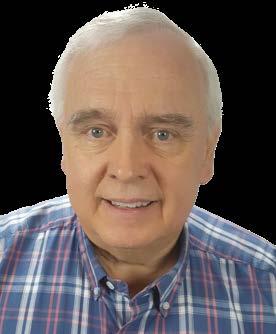
Remember Kenneth Lundgren’s unidentified audio transformer, discussed earlier and pictured here? There was no identification marking, so Kenneth invited thoughts from our readers about the type of transformer.
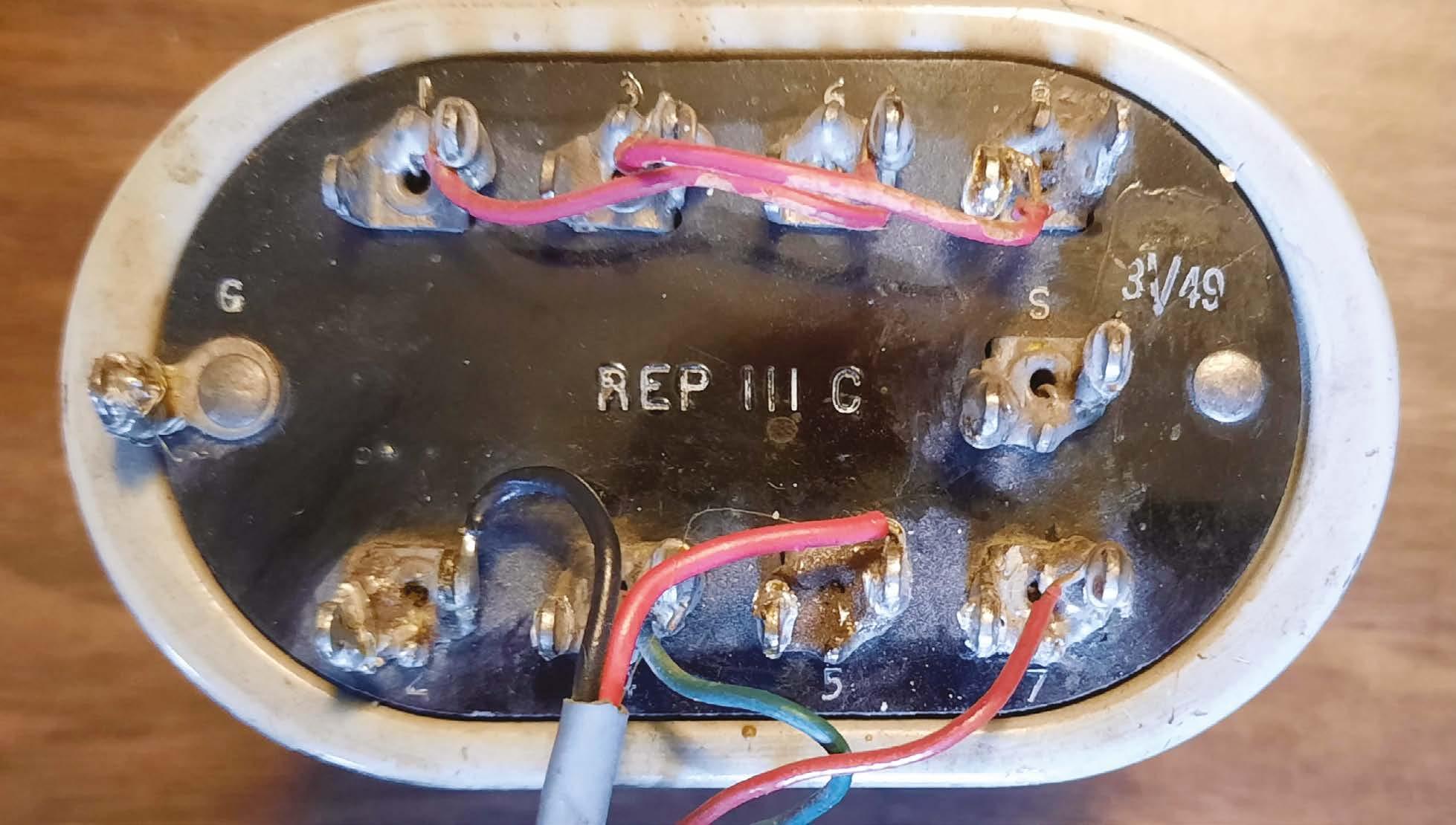
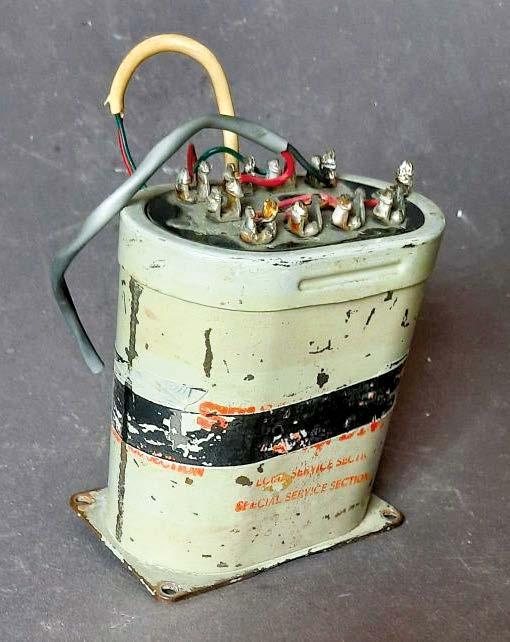
Rocket Engineering Principal Rolf Taylor believed the answer to Ken’s question might be in notso-plain sight. Rolf recalled that in addition to the printed nomenclature on the side, there should be an inscription “REP 111C” embossed into the insulator on the top. Online pictures confirmed this. So Rolf suggested that a quick flush with contact cleaner might solve the mystery.
Before I could pass on Rolf’s suggestion, Kenneth emailed to say that he had indeed cleaned off years of crud from the insulated top and sure enough found the embossed legend as shown here.
Ham and broadcast engineer Sheldon Daitch sent us an information sheet from 1980 that describes the variety of AT&T repeat coils or audio transformers. The more common models are 111C versions, but others exist as seen in the accompanying image on page 12, which depicts 111A and D models as well as C type.
(If you’d like a PDF of that image with better resolution, just email me at johnpbisset@gmail.com.)
You can be a transformer too!
Your tips for Workbench will help a colleague become a better and smarter engineer. Email johnpbisset@ gmail.com

Even the BBC used these Dave Porter is a retired BBC senior transmitter engineer. He tells us that the BBC used similar transformers in connecting studios to transmitter sites.
They’re known in the U.K. as REP coils, short for repeating coils. Dave writes that the BCC designed many of these models in-house. What made them and the Western Electric versions so popular was their four windings that could be connected to give a 600-to-600 transfer, a 150to-600 transfer or a 150-to-150 transfer by series / parallel combinations of the terminals on top.
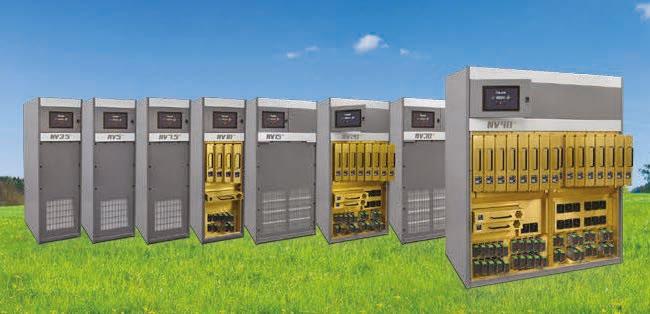
On the 250 kW Marconi BD272 HF transmitter used in the mid-1960s, an RF demodulator was provided using a sniff of RF from the final RF stage. An EY84 (US 6374) tube was used as the diode, rated to 625V RMS at 125 mA! The output was to a 600/600 rep coil to provide an audio feed.

Physically, the BBC version was an 8-inch cube. There was certainly no danger of the usual zero level, 0 dB (0.775V into 600 ohms) at 40% mod and the +8 dB on program to 100% modulation overloading that component!
First do this, THEN do that
After reading our column in April about maintaining your AM antenna tuning unit, broadcast engineer Paul Sagi in Malaysia sent a reminder.
Before shorting a tower to ground, consider discharging with a high-voltage discharge stick so that when you do the shorting, there will be less of an arc, or none.




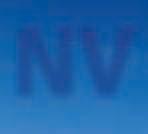


When shorting, be sure to connect the ground end of the shorting cable before you connect the tower end. If you connect the tower end first (especially if you did not first use the discharge stick), your body may become the short to ground! That tall tower may be absorbing RF from other adjacent towers.

Be careful around high voltages. There are no second chances or do-overs. They can kill a person instantly, even if the current is fairly low.
Hey, do you like your shrink?
We wrote earlier about heat shrink including 4-to-1 shrink and printable shrink (Brother makes a great shrink printer).
Mike Pappas is VP for business development at Orban Labs. He recommends adhesive-lined shrink
sheet from AT&T Labs. Email me at johnpbisset@gmail. com for a PDF version. Below Digi-Key offers adhesive-lined heat shrink.
repeated use just when you need them the most. They take longer to shrink because you have to heat up the adhesive with your heat gun, but properly applied, they provide robust weatherproof junctions and serious mechanical stiffening.
Note that adhesive-based shrink is notoriously difficult to impossible to remove. User beware.
Mike sources his shrink from Digi-Key Electronics, which has a myriad of it in all kinds of sizes and configurations. At this writing they listed 15,000 SKUs.
The final image here shows a compression F connector with adhesive lined shrink on it. You can see the adhesive “beads” on each end of the shrink. That connector is now weatherproof and it’s never coming apart.

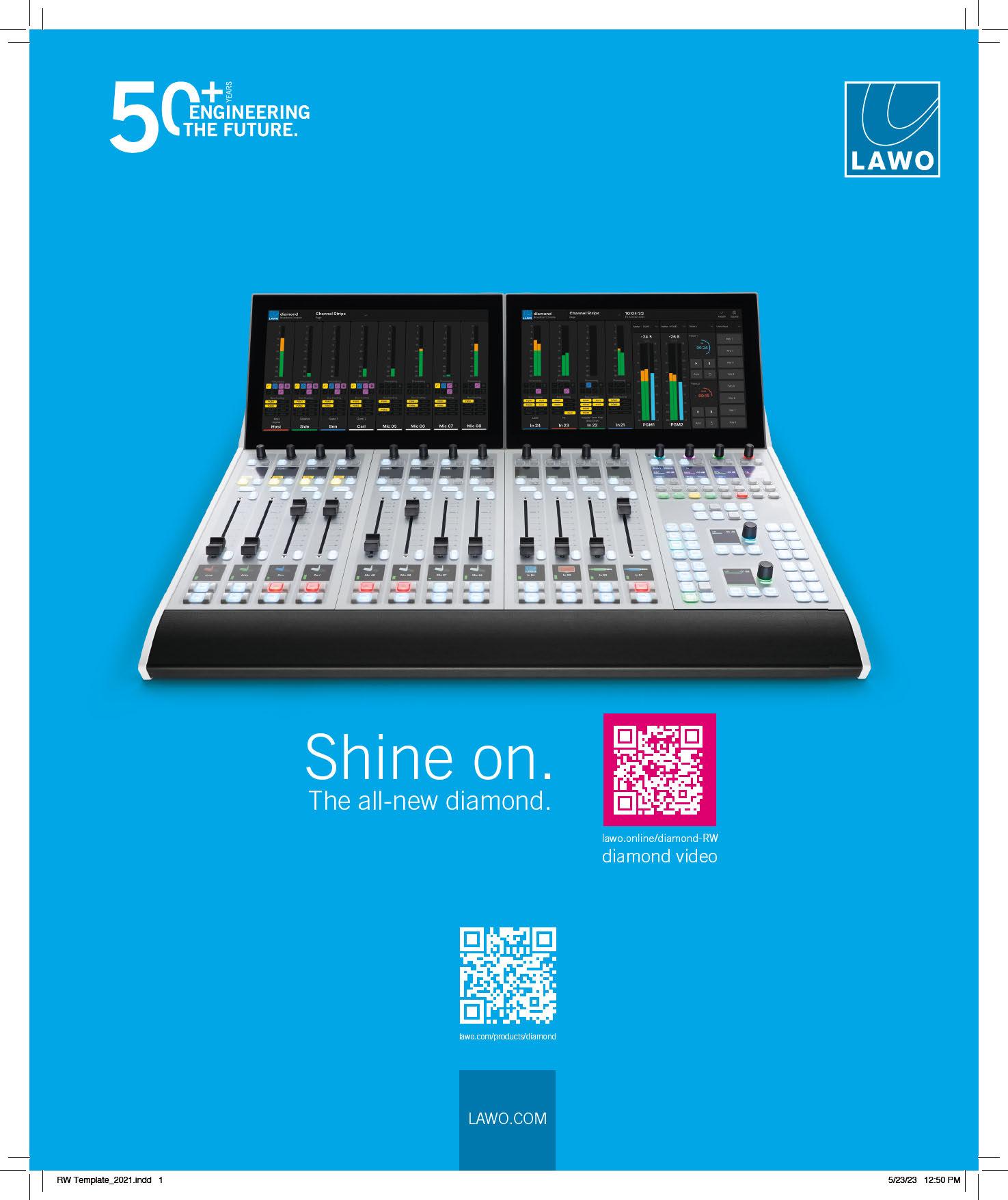
Aldena ABM Electromagnetic Field Meter
It’s a broadband (DC–65 GHz) electromagnetic field meter designed to measure and control field strengths in compliance with personal health and safety requirements per international limits like ICNIRP, IEC and IEEE. It allows accurate measurements in real time with minimal effort from the operator.
Features include interchangeable plug-and-play probes; high measurement stability and dynamic range; a data logger that can store 2 million records; an integrated GPS receiver; temperature and humidity sensors on board; and a rechargeable battery and protective cover.
In the booth, Carlo Perotta and Pablo Gelvez celebrate.
Info: www.aldena.it/abm-emfbroadband-meter/
These products are award winners!
Here are the products that won the “Best of Show” Award from Radio World at the 2023 NAB Show. Awards were also given by our sister brands TV Tech, TVBEurope, Mix, Sound & Video Contractor, NextTV and Broadcasting + Cable.
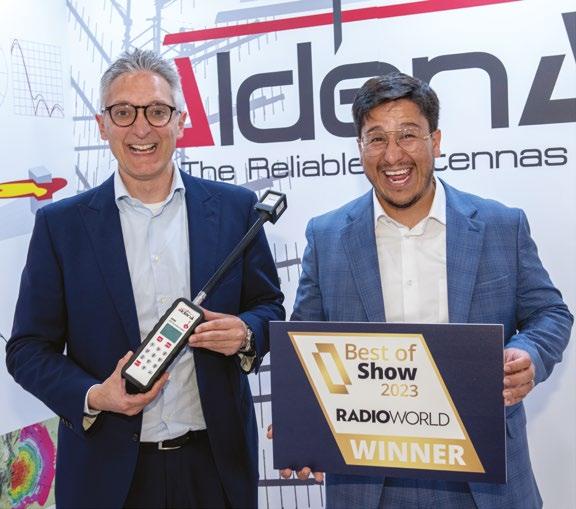

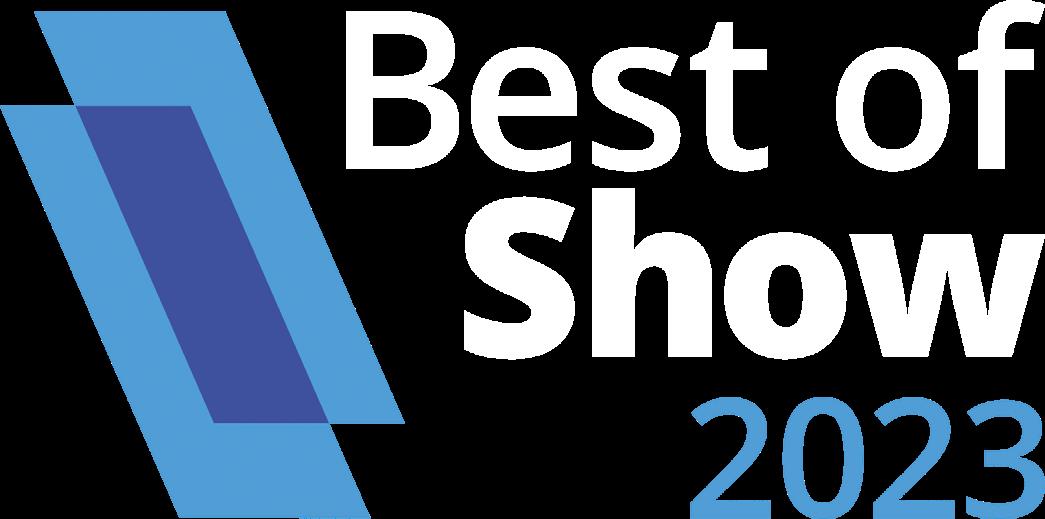
Participants pay a fee to enter; not all entries are chosen. Information about how the program works is available in an FAQ section at https://future.swoogo.com/nab2023
Omnia Forza
Forza is a software-based approach to multiband audio processing. It’s a stereo processor optimized for HD Radio/DAB and streaming audio. Frank Foti and his team deployed new AGCs and multiband limiters that deliver a polished audio signature that isn’t heavy-handed.
As we noted regarding the Inovonics product on page 18, it’s great to see more and better solutions emerging that specifically help support radio’s online sound. Forza does so using Omnia Sensus codec conditioning for low-bitrate streams, and it has a LUFS target-driven ITU-R BS.1770 loudness controller to comply with the demands of streaming platforms. “Launch point” presets and a smart user interface make setup easier.
Forza (the word means force or strength in Italian) is available now as a software container. It will be a processing option in Z/IPStream X/2 and R/2 as part of a planned update to those products. A container-delivered FM version is in development.
Leaning in on good processing are Paul Kriegler and Frank Foti. Info: https://telosalliance.com/forza
Ecreso FM AiO Series Transmitter

Occupying only two rack units, the AiO Series is available at power levels of 100, 300 and 600 watts as well as 1 kW. Ecreso says the design reflects a shift towards “more software, less hardware,” limiting costs of purchasing and maintaining peripheral equipment.
The transmitter is available with an integrated Audemat RDS Encoder, multiband processing and APT IP Decoder. The latter is compatible with
APT’s SureStream software and APTmpX compression algorithm. Also available is SmartFM software, an artificial intelligence technology that uses dynamic rather than fixed RF power to improve operating efficiency.
Hardware features include new RF planar design and a hotswappable power supply and fan removable from the front panel. For remote configuration and monitoring, the transmitter has a user-friendly GUI and SNMP support. The Ecreso FM AiO transmitter is natively supported by Kybio network monitoring and comes with a free one-year subscription to that service.
Pictured from left are Tony Peterle, Gregory Mercier, Christophe Poulain and Chantal Fourgeaud. Info: www.worldcastsystems.com/en/
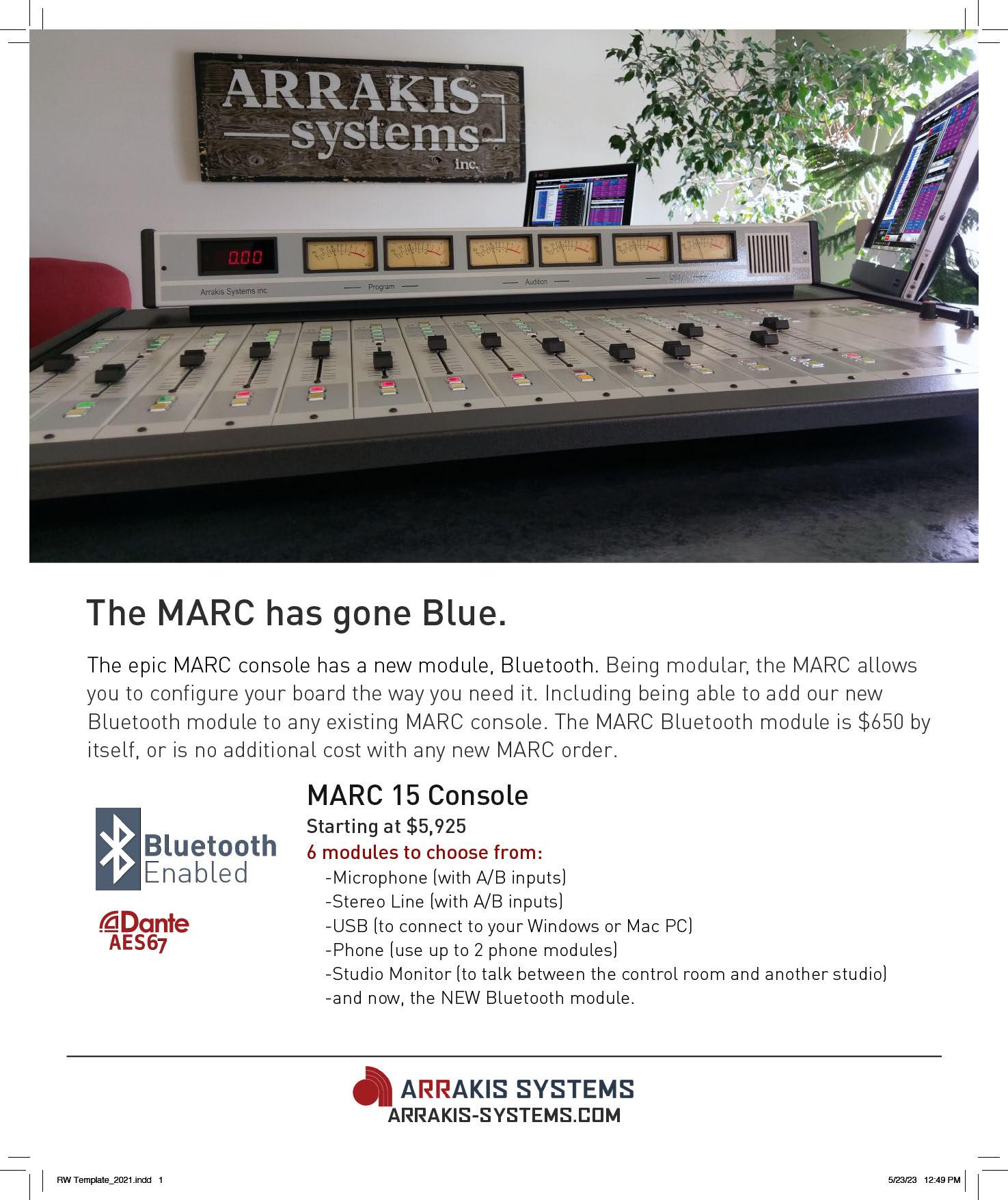
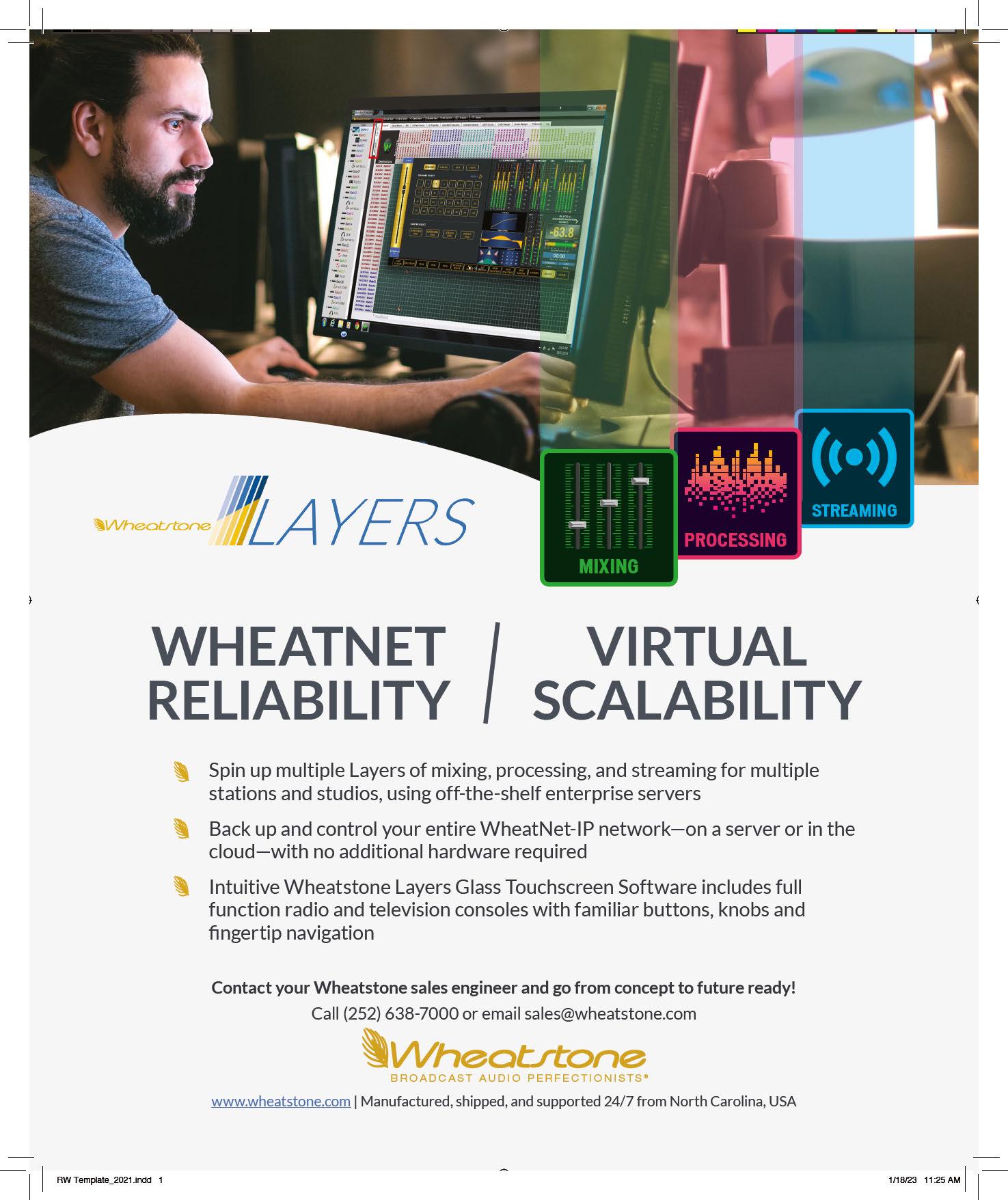

Futuri RadioGPT
It’s hard to recall a product that generated so much “buzz” at a tradeshow, at least since Voltair was shaking things up for PPM subscribers. And Futuri wasn’t even on the exhibit floor; the company had an official show suite. But people were talking about RadioGPT everywhere.
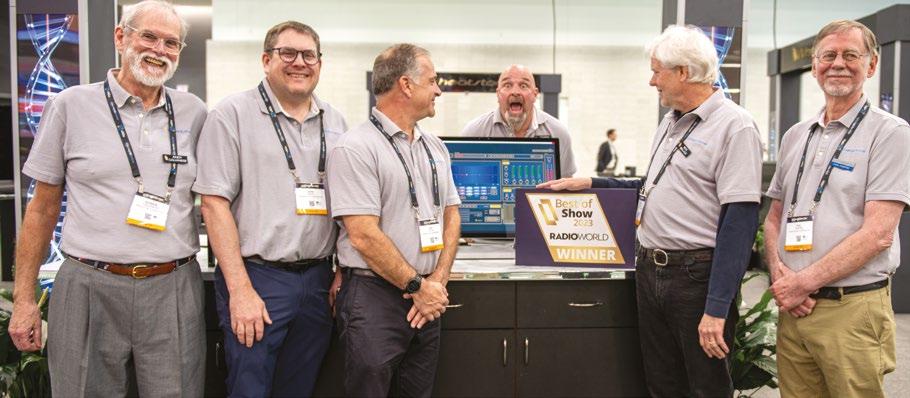
As Radio World reported in our April 26 cover story, Futuri calls RadioGPT the world’s first AI-driven localized radio content solution.
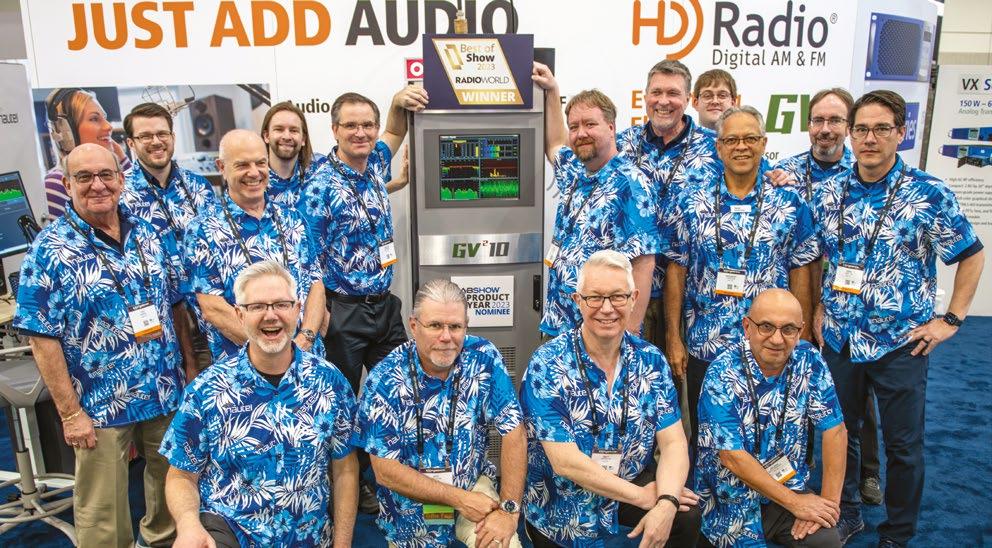

That promise of being “localized” is notable. The platform combines GPT-4 technology with AI voice tech, but it also deploys an AI-driven “story discovery and social content system” called TopicPulse to give the voices local content to talk about. It scans Facebook, Twitter, Instagram and a quarter of a million other sources of news and information, to find topics that are trending in your market. Then it creates a script for on-air use, and the AI turns it into audio voiced synthentically.
Info: https://futurimedia.com/radiogpt/
Inovonics 611 Streaming Monitor
Wheatstone Layers Stream on AWS
Wheatstone presented a cloud version of Layers Stream running on Amazon Web Services.
Layers Stream software includes stream provisioning, audio processing and metadata support. It’s part of the Layers Software Suite, which also has modules for running instances of FM/HD processing and mixing in cloud data centers such as AWS or on-prem servers.
At the show, Wheatstone demonstrated streaming instances running in AWS that can be brought up and torn down rapidly and controlled through a browserlike interface. Layers Stream includes audio processing for streaming and Lua transformation filters to convert metadata input from an automation system into any output format, including Triton Digital, for transmission to a CDN server.
The Layers suite has an FM module and mix module for radio and TV. Layers Mix has a full-featured mix engine and Glass virtual mixers for the laptop, tablet or touchscreen with routing, logic, automixing and native IP audio integration with automation. Layers modules can be used for remote or REMI applications between studios and cloud centers or for extending studio failover redundancy across multiple data centers.
Darrin Paley popped his head up for our photo. On either side, from left, are Andy Calvanese, John Davis, Jay Tyler, Rick Bidlack and Phil Owens. Info: www.wheatstone.com/layers
Nautel GV2 Transmitter
After a big 2022 when it introduced its snazzy 551 and 552 mod monitors, Inovonics showed another member of that family with the new 541 monitor. Yet it was the 611, a streaming product, that caught the judges’ attention. It’s great to see manufacturers investing in more and better tools to support that part of our business.
The 611 is a second-generation, dedicated hardware device for uninterrupted monitoring of network streaming such as your online internet radio service. It provides balanced analog and AES digital outputs and selflogging alarms for loss of audio, stream or internet. If the stream is lost, the 611 continuously tries to reconnect.
The box supports HTTP and HTTPS streams. Formats including Icecast/ Shoutcast and HLS (Ras, MPEG-TS, fMP4). A Stream Rotation function will rotate through preset streams sequentially, monitoring one stream at a time.
Shown with the box and its on-screen interface are Ben Barber, Josh McAtee, Gary Luhrman and Zach Calden.

Info: www.inovonicsbroadcast.com/product/611
The slogan for this transmitter line is “just add audio,” and the phrase is suitable given how much is built into it.
Nautel says it hopes the simplicity of this line will encourage a fresh wave of HD Radio adoption. The GV2 integrates all HD Radio components, with Xperi Gen4 Importer, Exporter and Exgine implementations for HD Radio encoding, station logo and Artist Experience. It also locks FM and HD signals synchronously to eliminate HD FM blend drift. “Omnia for Nautel” handles covers FM and HD Radio audio processing and provides Livewire AoIP inputs.
A notable air-chain selector allows the transmitter to select one of many inputs (FM and all HD) and change from one feed to another, regardless of where the feed originates. The transmitters feature the new generation of the Nautel Advanced User Interface, based on HTML5.
Plus, great shirts.
Info: www.nautel.com/products/fm-transmitters/gv-series/
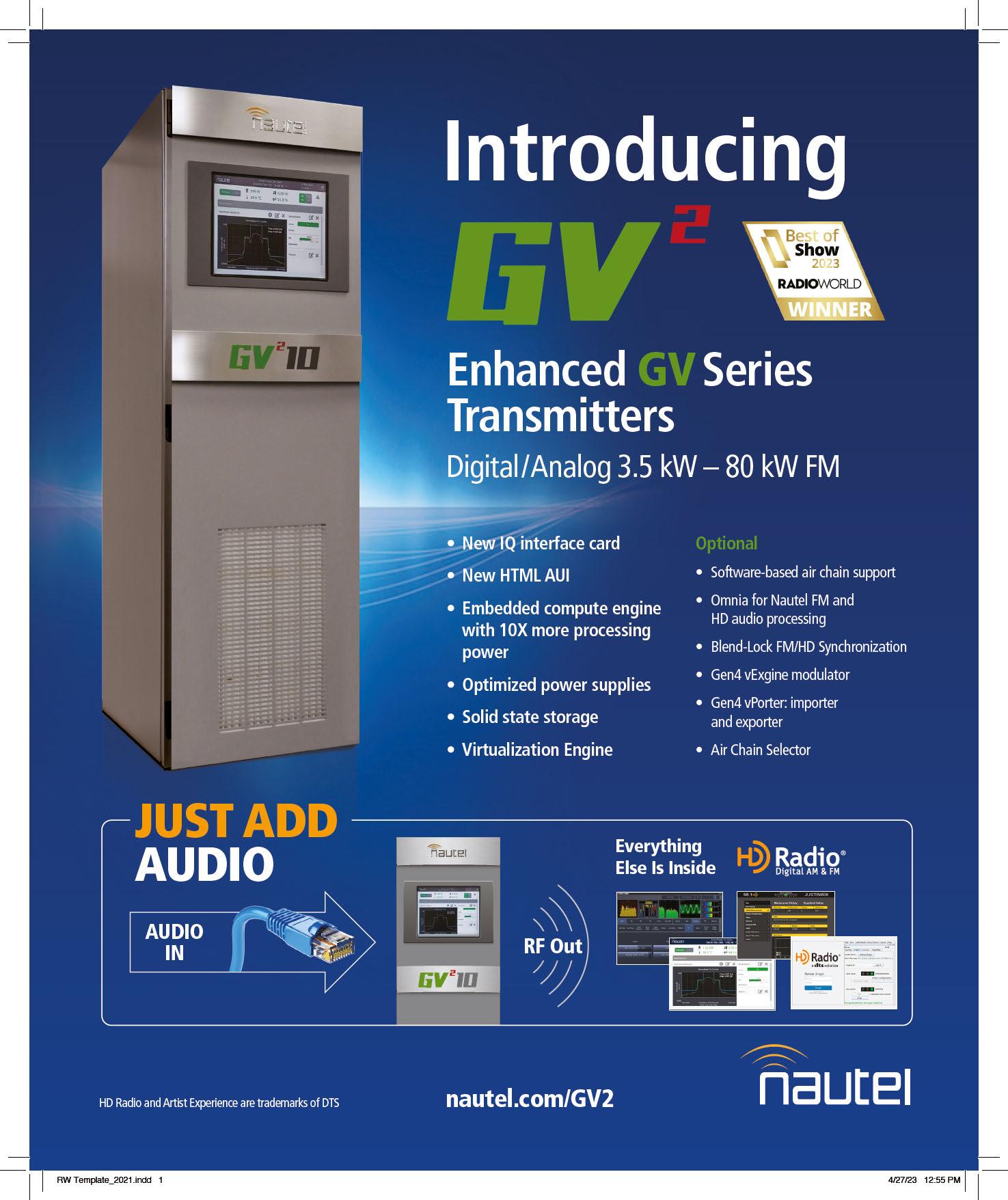
Orban Optimod
5950 FM/HD Processor
President David Day described the Optimod 5950 as the “first ‘clean sheet of paper’ Orban processor since the 8400.”
It uses a processing architecture called the Orban New Platform. ONP is a flexible hardware design that supports two to eight DSP and multiple sub processors. It handles AM, FM, FM DAB+, FM HD1 and AoIP with local audio playback and watermarking, all in a 1RU form factor.
Orban highlights the quality of the MX limiter, multipath mitigator/ phase corrector and subharmonic synthesizer. The box simultaneously processes one stereo program for FM and DAB+/HD Radio/streaming; the settings can be coupled to make the HD Radio blend smooth; or the FM and DAB+/HD Radio/streaming can be adjusted independently, which is helpful when the digital processing drives a channel that does not require blending, such as an internet stream.
Available options include two internal Nielsen or Kantar Encoders and a μMPX interface.
Shown are David Day, Peter Lee and Bob Orban. Info: www.orban.com/overview-optimod-5950-audio-processor
Elenos Group Quick Block
Quick Block is a transmitter platform that aims to take modularity to the next level. Elenos highlights its high efficiency, scalability, simplified maintenance and significantly reduced footprint.
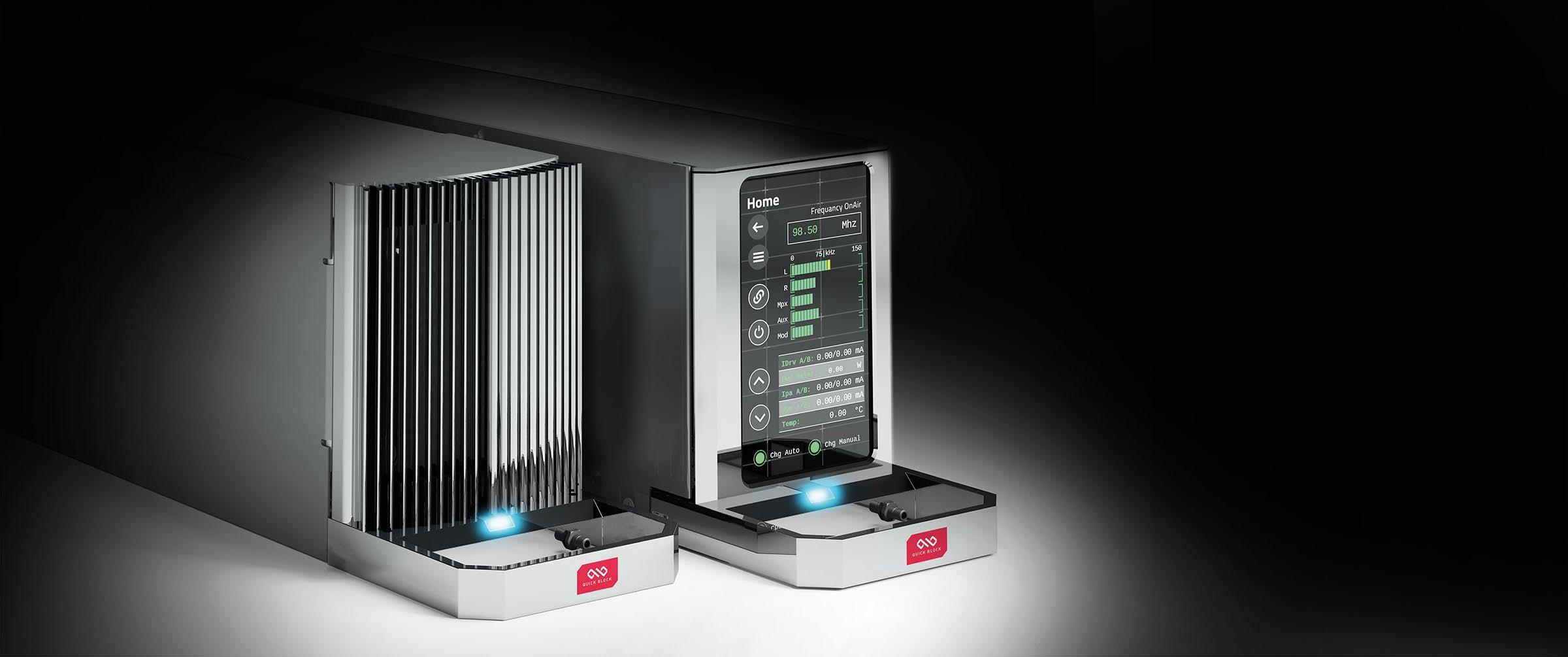
The modules are compact, lightweight and easily shippable. “Using the same simple building block, you can scale a transmitter from 1 kW to over 50 kW for analog and HD Radio FM broadcasts,” the company says. Elenos showed a 50 kW transmitter in a single 19-inch rack.

Features include multiple modular and software-defined exciter options; an HD Radio upgrade path; and control from front-panel screen or remote HTMLbased web GUI interface with no Java or Flash.
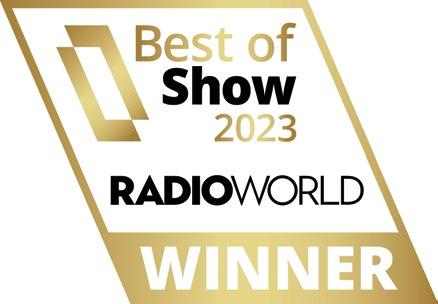
Controllers, power supplies, RF amplifiers and exciters are all hot-swappable by personnel with basic skills.
Shown from left are Morten Simonsen, Rich Redmond, Leonardo Busi, Luca Buscherini and Perry Priestley.
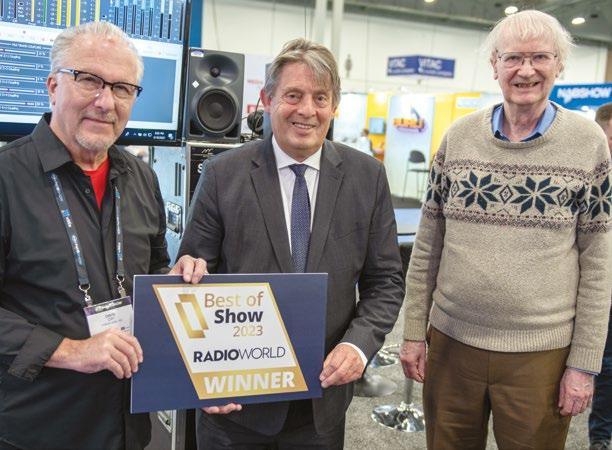
Info: www.quickblock.com/en/
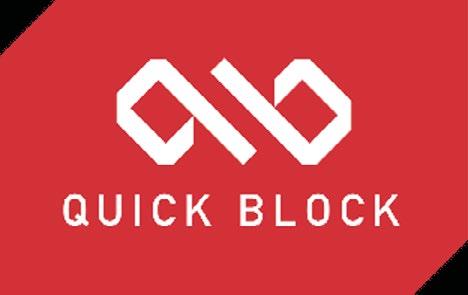
Radio.Cloud Live Studio
Much has been said and written about the cloud, but Radio.Cloud is putting it into practice. Its cloud-native platform allows live broadcasting using a web browser. The company says it is the only automation system certified as a partner of Amazon Web Services.
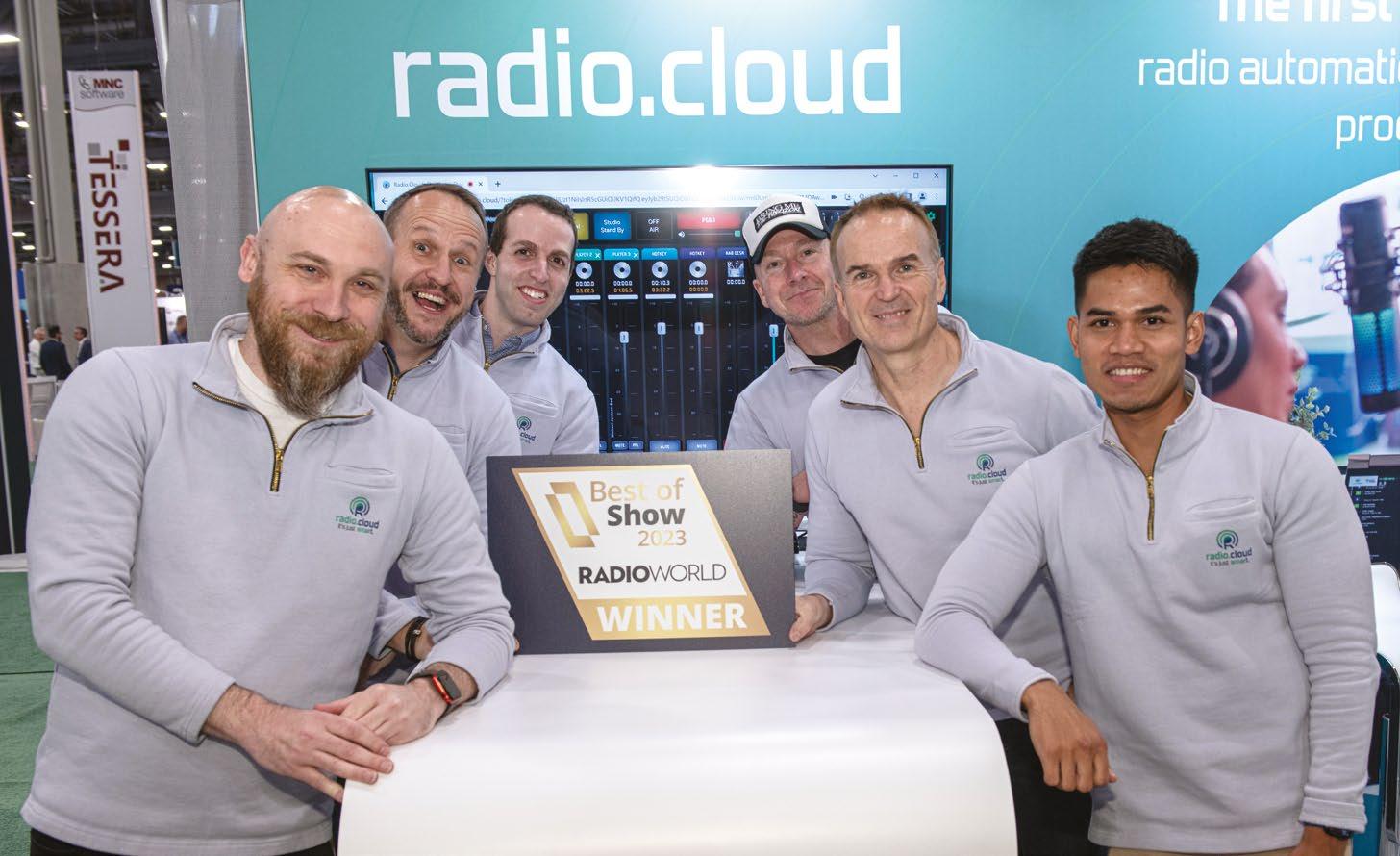
The software combines all the functions to broadcast live on terrestrial, digital or internet radio. Regardless of location, your hosts, co-hosts and guests see a configurable layout of channels including playlist audio, hotkeys, IP/SIP phone control and mic channels. Guests can be invited via a system-generated email link.
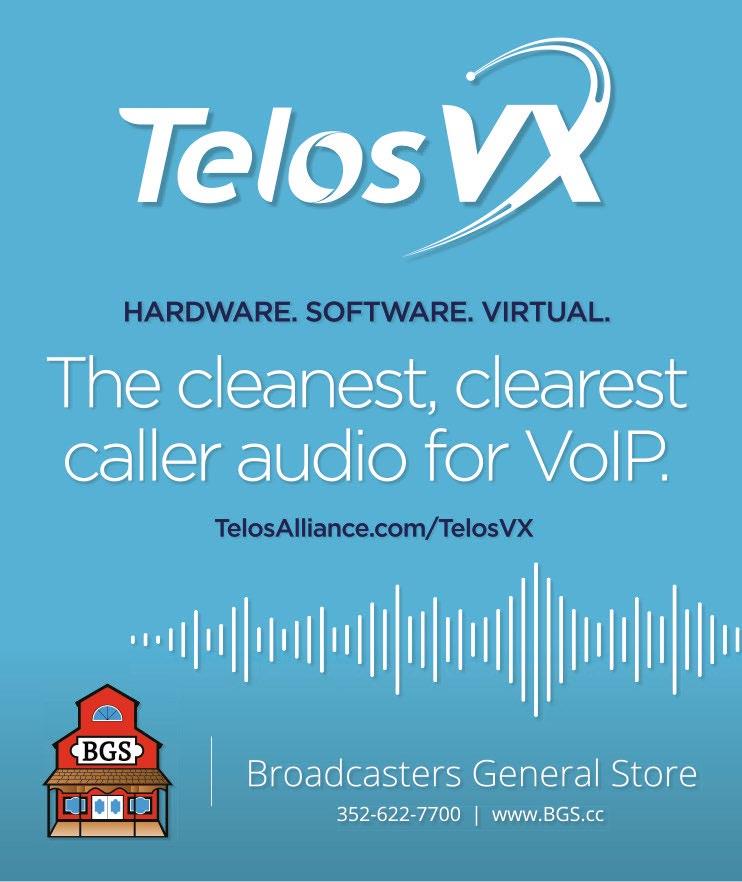
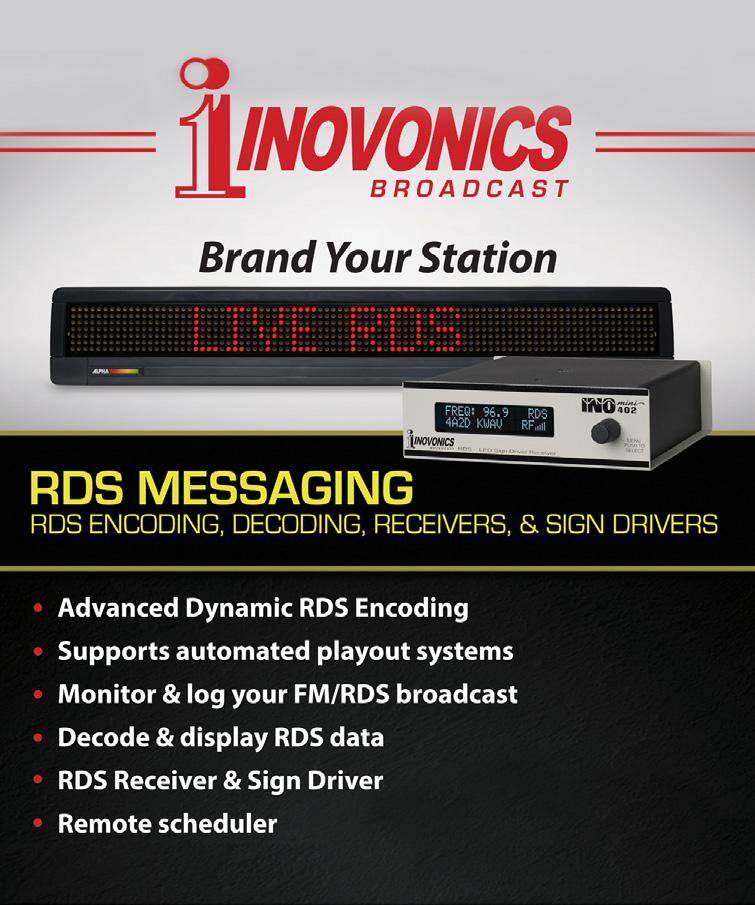
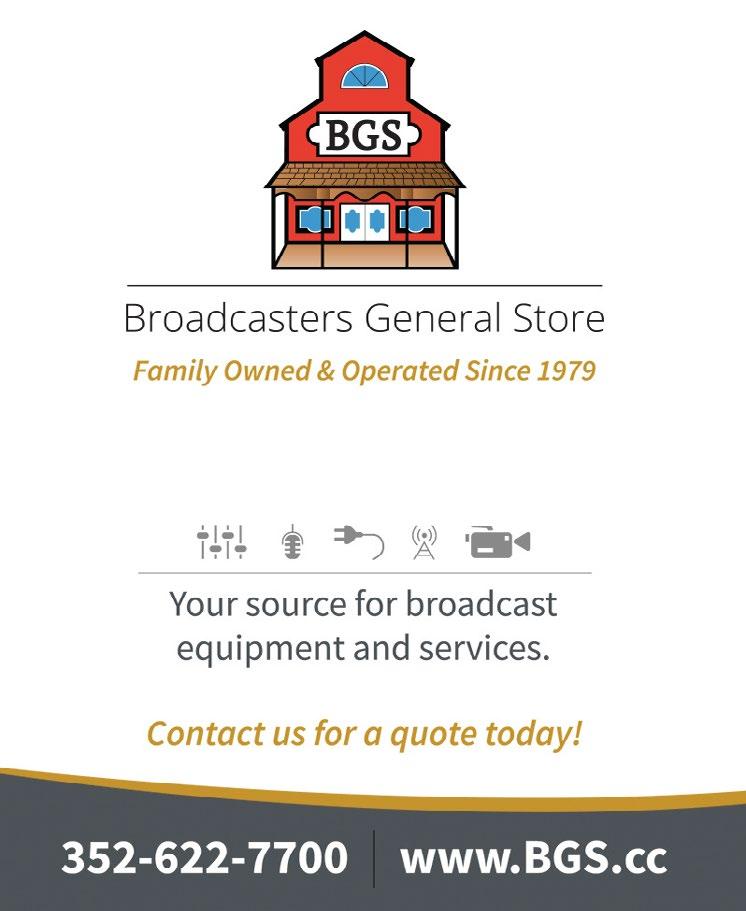
The software allows you to drag and drop audio from a library into the playlist or hotkeys, and to reorder the playlist.
Live Studio allows the talent to go live from anywhere with any level of equipment; they just need a microphone, a computer or tablet and an internet connection. Radio.Cloud says milliseconds latency and high throughput performance are possible through your web browser.
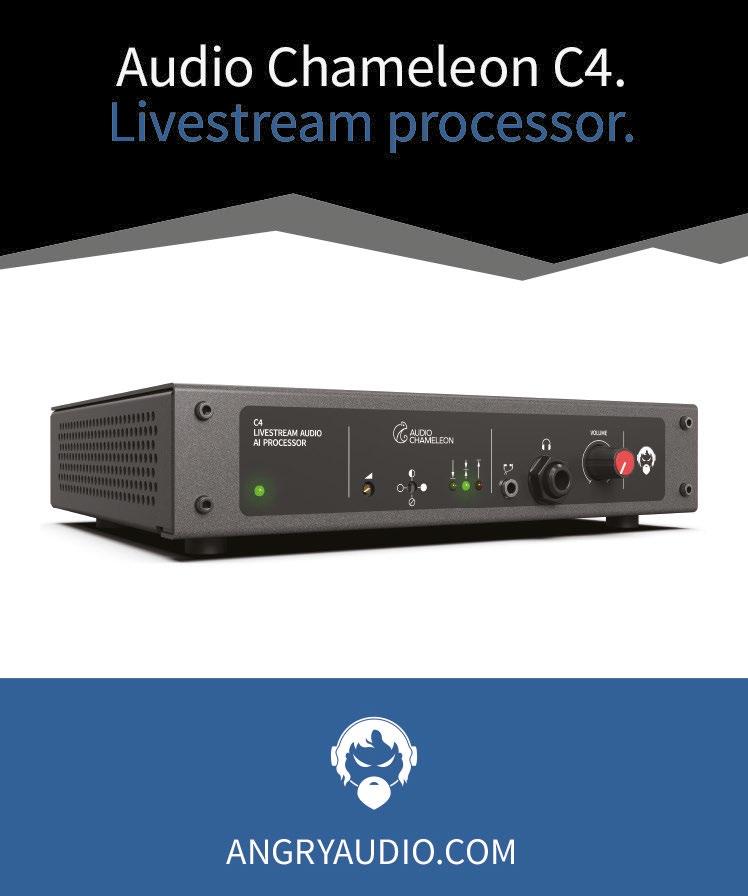
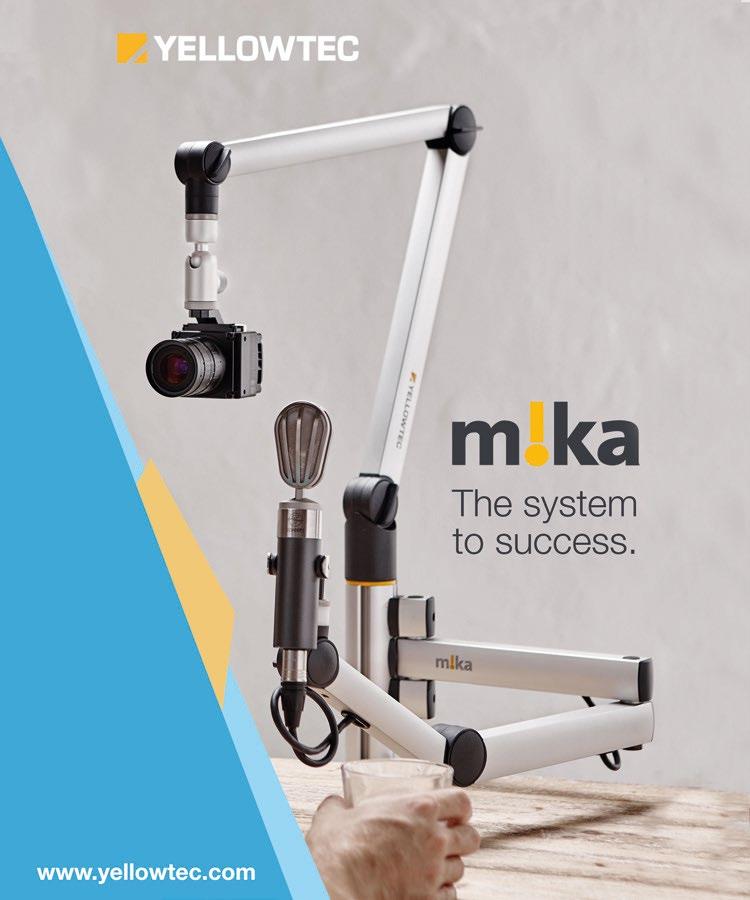
Gathered ’round are Shawn Gilbert, Alex Nowotny, Andrew Scaglione, Jott Lischka, Christian Brenner and Adi Darmadi.
Info: https://radio.cloud
Tieline MPX II Codec
At the NAB Show, Tieline unveiled the MPX I and MPX II codecs for realtime network distribution of FM-MPX or MicroMPX (µMPX) signals to transmitter sites.



Sending “transmission-ready” FM composite signals allows you to keep your audio processing and RDS gear at the studio. “Composite MPX over IP signals can be easily replicated and distributed using multicast and multi-unicast technologies and take advantage of rock-solid redundancy features like redundant streaming, RIST, FEC and automated SD card file failover.”
The MPX I is suitable for transmitting a composite STL signal from a single station with return monitoring, whereas the MPX II can transport two discrete composite FM-MPX signals from the studio to transmitters with return monitoring.
The products will ship later this year. Both support analog MPX on BNC, MPX over AES192 and multipoint signal distribution, to deliver composite encoder and decoder solutions for various uses.
They support sending the full uncompressed FM signal, or high-quality compressed µMPX at much lower bit rates.
Info: https://tieline.com/tieline-unveils-mpx-solutions/
GatesAir Flexiva GX Transmitters
Introduced at last fall’s IBC show, this is a family of aircooled, solid-state analog FM transmitters with a very compact format.
“Broadcasters seeking to refresh existing analog FM infrastructure with cost-, space- and energy-efficient systems for large regional and national networks represent a key customer base,” GatesAir said.
The line includes 50-watt, 1 kW, 5 kW and 10 kW versions so far. The company highlights the exceptional power density in a 5U chassis thanks to the latest LDMOS technology, and cites an overall efficiency rating of up to 76 percent.
Axia Altus
This new offering aims to bring the features of a traditional console to your phone, computer or tablet via browser.
“Full-function mixing — including eight virtual auxiliary mixers and integration with Telos VX broadcast phone systems — allows distributed and remote workforces to collaborate on recorded programs and live broadcasts, including contribution audio and monitoring,” Telos Alliance says.
Altus is offered by subscription or one-time buyout. It is particularly suited to situations where fast deployment is necessary, such as setting up a temporary studio, building a disaster recovery center or launching a remote broadcast.
Altus is delivered as a Docker container and can be used on- or offpremises with COTS hardware.
Info: https://telosalliance.com/Altus
Features include hot-swappable power supplies and auto-switching inputs, with dual AES (including AES192), dual composite and analog left/right audio inputs. The line supports N+1 configurations, helpful for large national network operators.
Options include a GPS receiver to support SFN functionality and a new Intraplex IP Link 100e module that integrates in the transmitter, enabling receipt of contributed FM content instead of requiring a codec.
Info: www.gatesair.com/products/transmit-radio/ fm-transmitters/flexiva-gx
Xperi DTS AutoStage Broadcaster


Portal
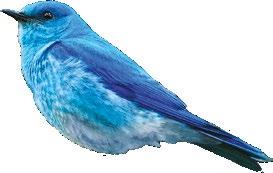

If your station or group supports DTS AutoStage, this portal allows your PD or sales manager to see where people are listening, when they listen and what content they like.

For instance a nifty heat map graphically represents your coverage based on vehicles in the market that are listening to your station; you can select times of the month and week based on the transmission systems you use (AM, FM, DAB, CDR or HD Radio). The map provides a bird’s eye view of your coverage area and can also zoom to the neighborhood level.
Charts reveal what users are listening to, including which songs are most popular or which ads were listened to the most. You can get data such as the percentage of total vehicles in the market listening to the station and how that changes over time. And turnaround is quick; you can get the results of an on-air event or format switch within a day or two. The portal is also a hub from which you control your branding and metadata, with changes showing up immediately to the listener’s car radio.
Shown are Juan Gonzalez and George Cernat. Info: https://dts.com/autostage
Apps for Radio Technology

About Buyer’s Guide
This section appears in every other issue, focusing on a particular category of equipment and services. It is intended to help buyers know what’s on the market and gain insight into how their peers are using such products. Today: Apps for radio technology.
Tech Update
Mobile Remote Access and Control From Burk Technology
Flexible remote access is the promise of Burk Technology’s ARC Plus and ARC Solo remote control systems.
“The convenience of smartphones and tablets allows quick access from anywhere,” the company says.
Each remote control unit comes with a built-in web page that automatically switches between PC and mobile displays. Users can make a direct connection to the remote site to access status, metering and command channels, execute macros and manage alarms. Each user sees a customized view limited to channels authorized for that account.
For users with multiple sites, Arcadia from Burk provides comprehensive mobile access and control, consolidating access to all their remote facilities over one secure web link regardless of the size of the network. Graphical control views display summary information from multiple sites, enabling managers and engineers to determine the status of their entire operation.
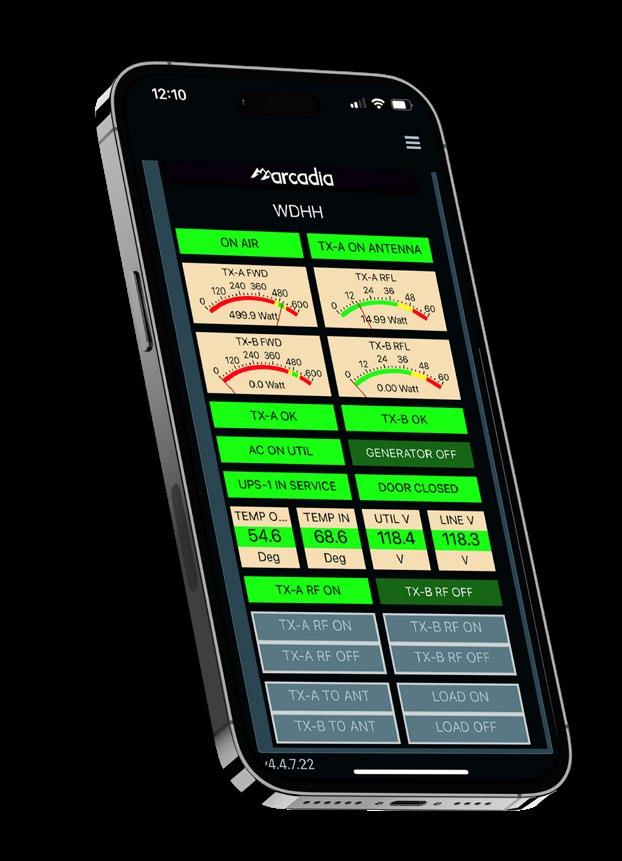
Tech Update
Users can drill down to access summary data at national, regional and market levels. Displayed site data can be customized based on the needs of individual users or groups.
The Arcadia server can be in the cloud or on customer premises. Arcadia monitors all connected sites, accommodating varying access speeds and retrieving the most current data from each site. When remote users log onto the system via their smartphone or tablet, a list of all authorized sites is displayed. A click on a listed site displays all the available channels.
Integration of external URLs in Arcadia views makes it possible to include websites and equipment interfaces in each user’s selection of screens.

Security is built into Arcadia. Web links use Transport Layer Security to ensure that only authorized users can gain access. Microsoft Active Directory or AD-LDS provides granular control over individual access privileges.
Info: www.burk.com

GatesAir Introduces IntraAlert Service App

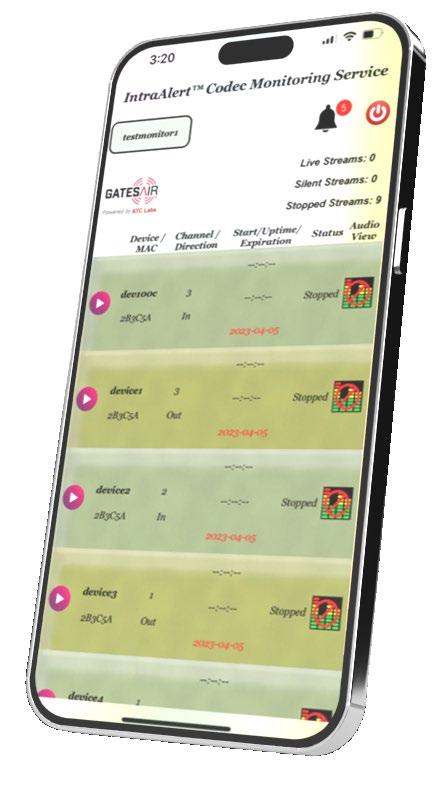
Just prior to the spring NAB Show, GatesAir released an app for its new Intraplex cloud monitoring service IntraAlert.
Developed by partner ATCLabs, the app provides access to cloudbased audio monitoring and alerting capabilities for Intraplex IP Link codecs and modules. It is available as a free download in Apple App and Google Play stores.

The IntraAlert service sends received and off-air audio streams to the cloud, which users can access via the app or a browser. They can activate IntraAlert within IP Link 100c codecs and IP
Link 100e plug-in modules for GatesAir’s Flexiva radio transmitters upon registering for the service, and access a suite of monitoring and alerting tools scalable for multiple codecs, streams and locations once logged in. Service options include live confidence monitoring for quality assurance, as well as real-time service alerts based on specific audio parameters. The latter can include silence thresholds, as well as content disruptions caused by artifacts or dropped packets. Users also have access to deeper performance analytics, including network-level packet analysis tools.
Info: www.gatesair.com.

Tech Update Mobile App Supports Telos Infinity VIP
The Telos Infinity Virtual Intercom Platform is a fully-featured cloud-based intercom system.
“It brings the same sophisticated comm experience as our Telos Infinity hardware to any HTML5-capable desktop or laptop computer, tablet or smartphone,” the company says.
“VIP enables media production workflows from anywhere, including communication and contribution audio. Users can even use thirdparty control devices, including Elgato’s Stream Deck, to control VIP.”
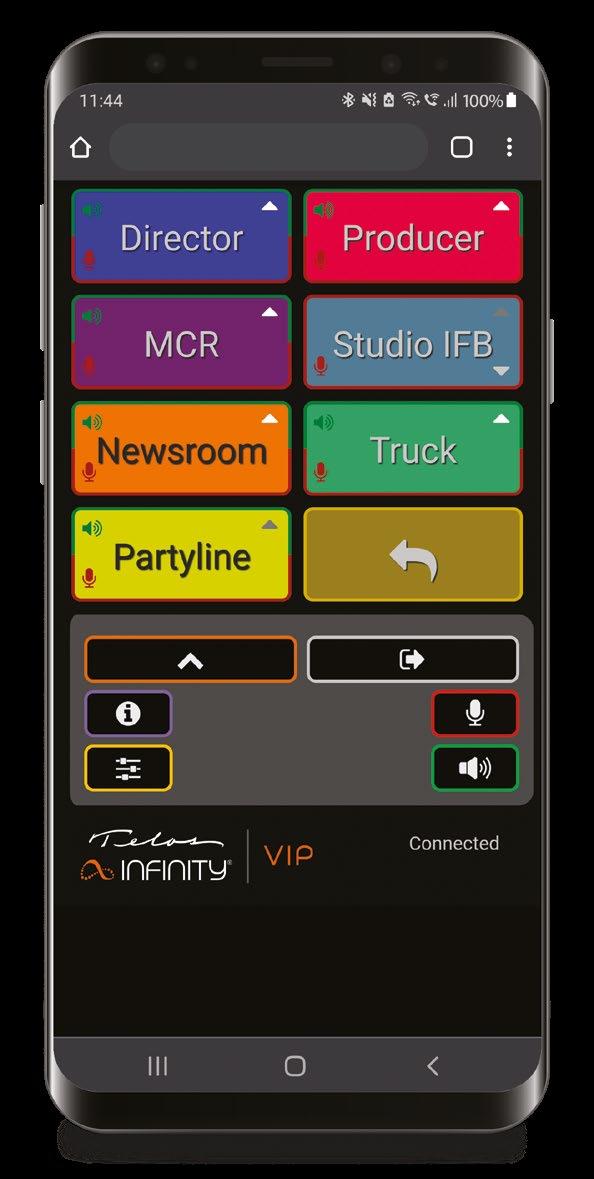
The Infinity VIP mobile app for Android and iOS devices is available to VIP users through the Google Play Store and Apple App Store. It eliminates the need to safeguard a browser tab to access a VIP panel.
“Guests can be provided with a secure link via email or chat to connect to a preconfigured VIP panel. We’re confident the VIP app is something broadcasters and content creators using Infinity VIP won’t want to be without.”
Info: www.telosalliance.com/contact-sales.

ENCO Expands Its AI-Based Offerings
Generative artificial intelligence can create entirely new content via pretaught artificial creativity. ENCO has been offering AI-based captioning technology for some time but now has introduced two new AI offerings, AITrack and ENCO-GPT.
They use the ChatGPT model to generate language responses from textbased queries added to automated radio production workflows.
“Consider a music show where your on-air staff may not have enough time to voice a pre- or post-roll for every song,” the company says. ENCO has developed a process where a station’s DAD system automates this process.
“For example, ask ENCO-GPT, ‘Tell me more about Pink Floyd’s ‘The Dark Side of the Moon.’ which then returns a couple of sentences that are fed to AITrack and converted automatically into a synthetic voice via TTS, whose recording is then automatically inserted into a playlist adjacent to the album or song.
“Synthetic voices are becoming far more lifelike and can include voices modelled after actual onair talent.”
Another use case would be using ENCOGPT to automatically create summaries of long-form interview transcripts or to compile a list of keywords found in a transcript.
“Simply using the transcript from a 20-minute interview and performing a summarize command in ENCO-GPT can create a summary for editorial or production purposes, while obtaining a list of keywords can provide data for any Search Engine Optimization (SEO) program that is in place.”
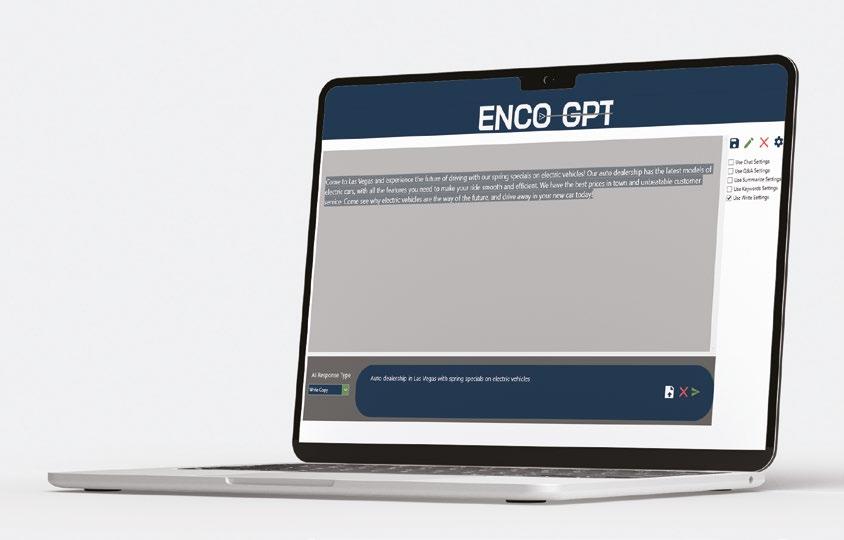
ENCO says these innovations can help support existing workflows and content by automating mundane tasks while broadening content options and making large bodies of text easier for producers and writers to manage.
Info: www.enco.com
Tech Update Track Your Inventory Remotely With NBS
NBS is software from NeoGroupe for tracking physical assets; it helps you manage the pieces of equipment you oversee: cameras, recording kits, racked servers, laptops, codecs, consoles, nodes, etc. Now it can even track which cables go to which ports of your network appliances.
“Most of the time, batches of equipment are followed up with into a spreadsheet by the technical team with little or no update over time,” NeoGroupe notes.
“NBS lets you find immediately where the equipment was seen last, who has it and which vendor sold it. It lets you also see in a click what equipment has been returned to a manufacturer for repair.”
You can do onboarding and off-boarding of employees, conduct inventories of all sites, create packing lists for events, follow up on items sent for maintenance, receive expiration notifications and link it with your Active Directory.
NBS now has a smartphone application. “With NBSSmart for iOS and Android, scan any item, enter any changes and perform inventory checks on the fly that will be of interest to your accountant,” NeoGroupe says.
“Change the holder of a laptop on the fly in a single touch. NBS and NBSSmart work with barcodes or QR codes.”
NeoGroupe also now offers offering hosting of the database in the cloud. “And we import your existing data for a smooth start.”
Info: www.neogroupe.com
Tech Update
Report-IT Enterprise GPIOs Integrate With AoIP
Tieline says its Report-IT Enterprise is the most popular iOS and Android codec app for high-fidelity live audio streaming with record, playback and FTP capability.
“It has more features when compared to SIP-based apps, such as redundant streaming capability, automated jitter management, and can be remotely controlled using Tieline’s Cloud Codec Controller,” the company says.
The version 3.6.x release of the app supports GPIO options when connecting to Gateway and Gateway 4 codecs using firmware v3.02.08 or higher.
“This provides broadcasters with flexible options for triggering a range of latched or momentary codec relay options,” Tieline says. “For example, Report-IT GPIOs can activate WheatNet-IP Logic IOs (LIOs) or Livewire GPIOs back at the studio, which can in turn adjust console settings or automation system tasks within the broadcast plant as required.”
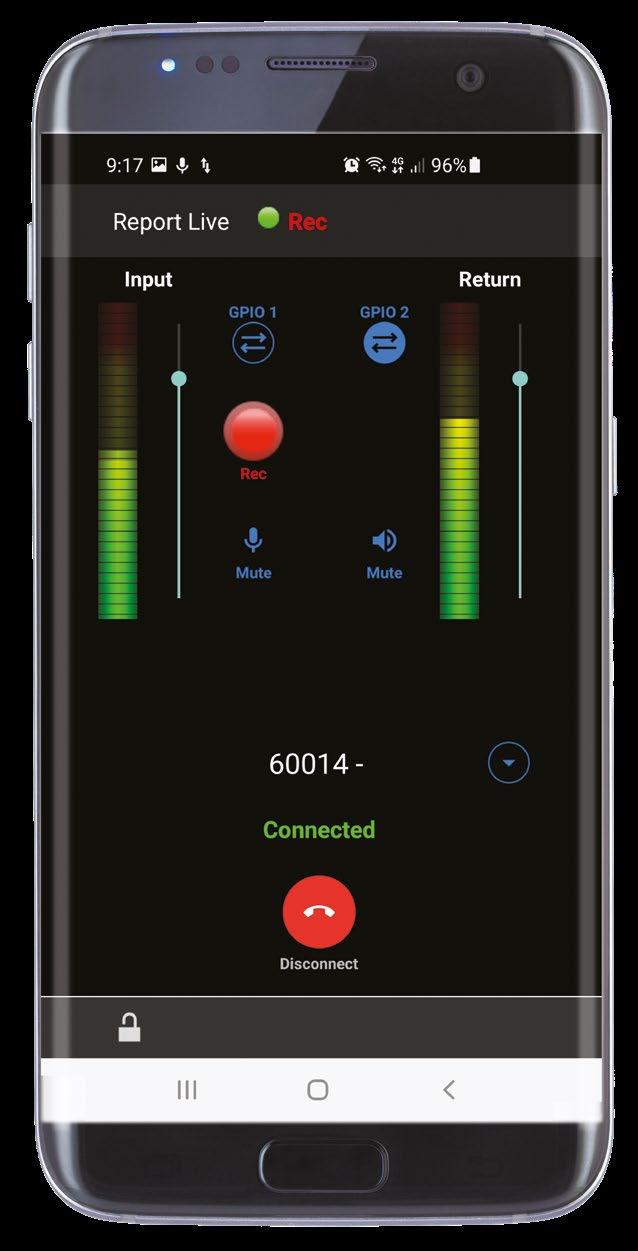
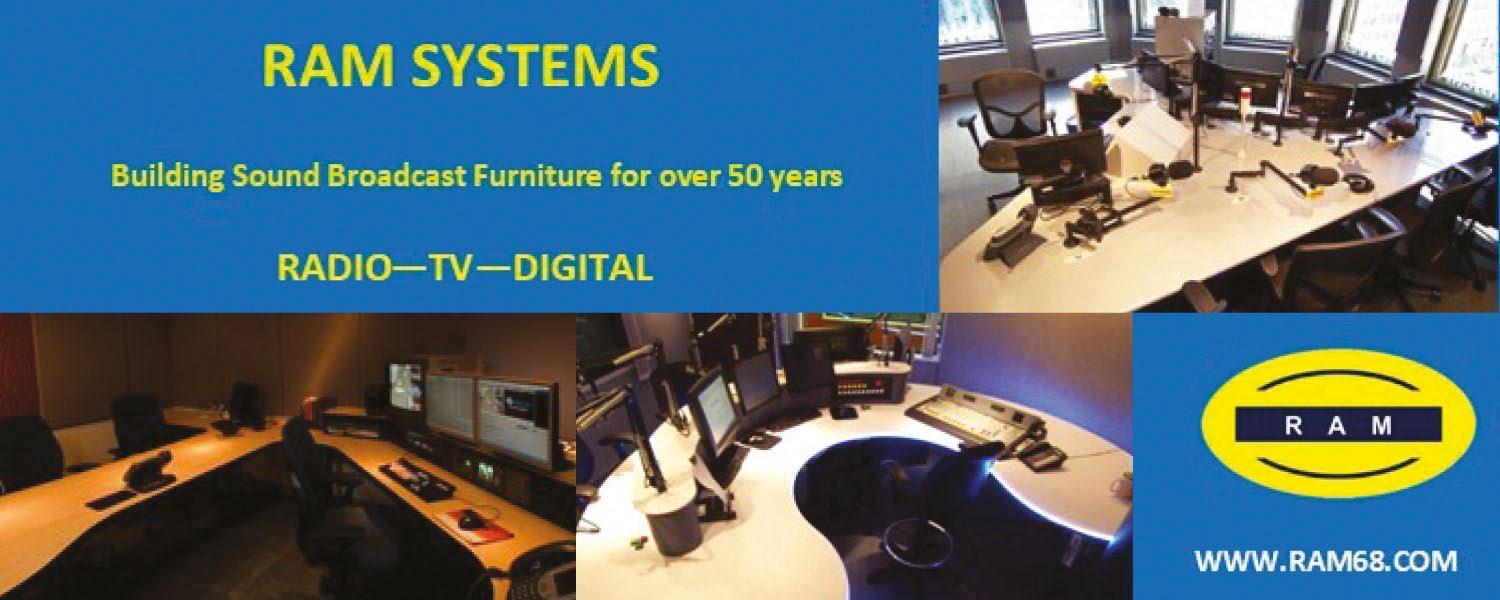
Two relay GPIOs can be displayed on the app’s Report Live screen, which support displaying activated and deactivated GPIs, as well as activation and deactivation of GPOs using the phone touchscreen.
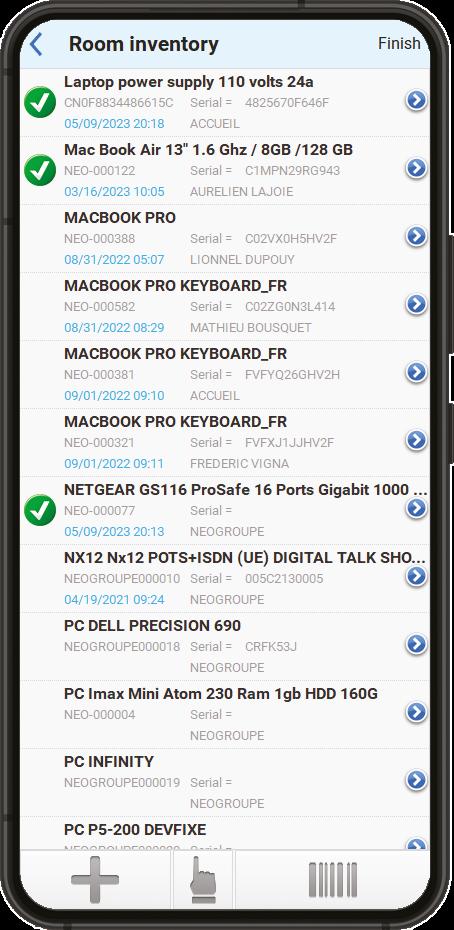
Account GPIO configuration is supported in the TieServer Console app for iOS and Android, as well as the HTML TieServer Web Console accessed via www.tieserver.com.
To learn how to configure Report-IT Enterprise GPIOs visit https://tieline.com/ report-it-support-page/ and download the GPIO tech note.
Shown is the Report-IT Enterprise app featuring GPIOs and Input Mute feature.
Tech Update Marketron NXT Empowers Local Media Sellers
Marketron NXT is a cloud-based platform that helps local media sellers grow linear and third-party digital sales. The company highlights the streamlined, automated design for executing proposals, orders, reporting and billing.
“NXT has a user-friendly, responsive interface that lets you build, modify and price proposals in real time with advertisers, so you can save time and close more deals,” it states.
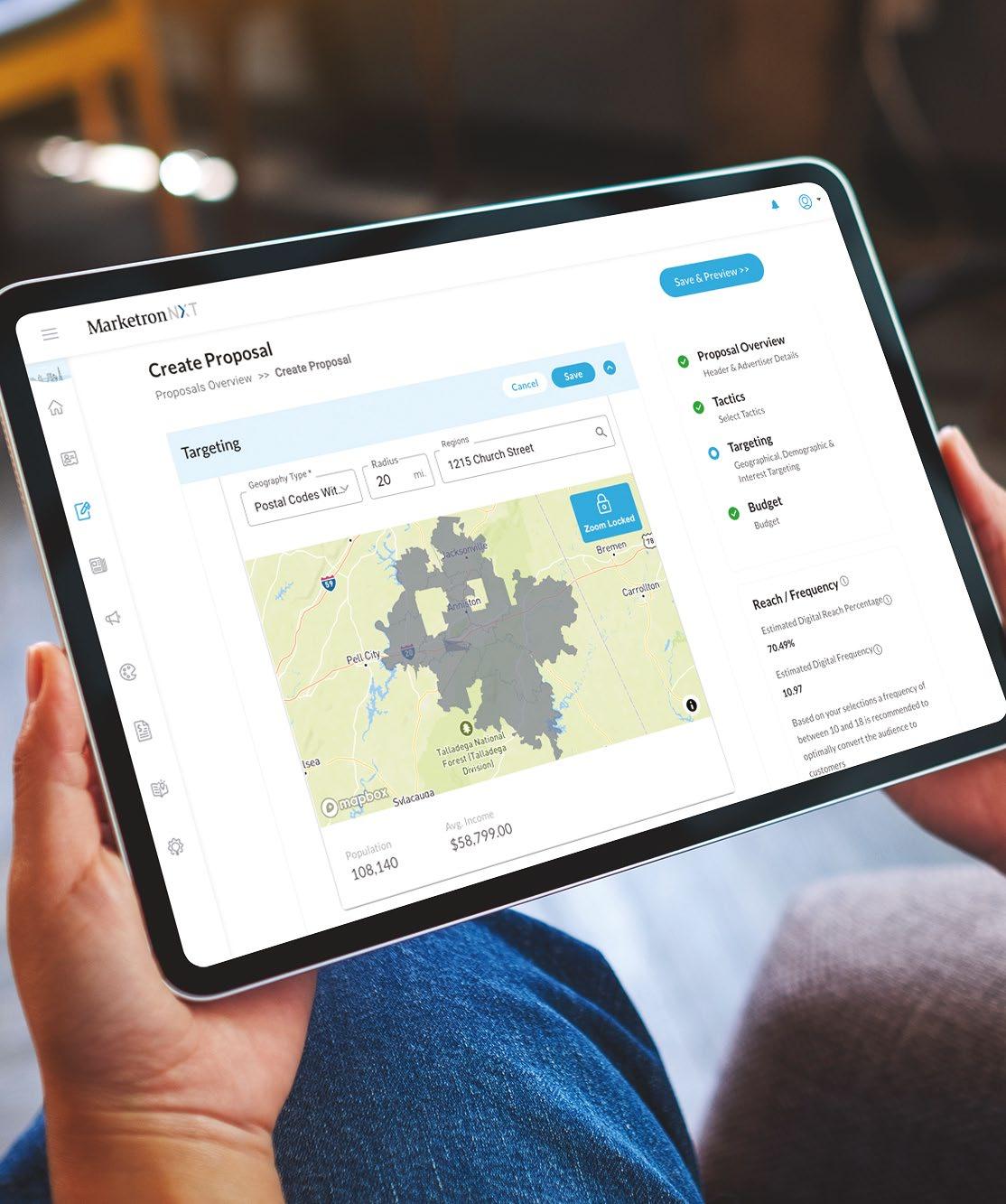
“No need to print papers and go over them line by line. With NXT, you can walk through a proposal with the advertiser right next to you. Open NXT on any size browser screen, choose tactics to meet an advertiser’s campaign budget and goals, and integrate traffic orders directly from a proposal.”
Features include weekly deployments, advanced advertising tactics, responsive design and an intuitive web interface.




Info: www.marketron.com/demo-nxt
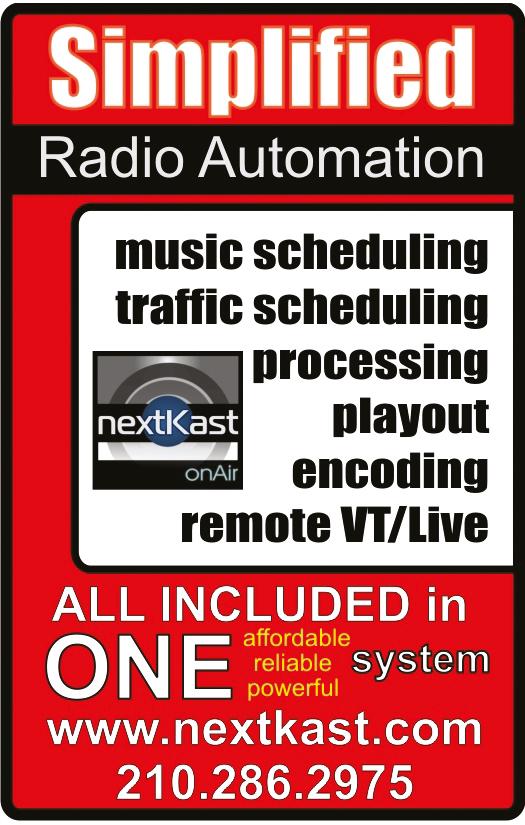
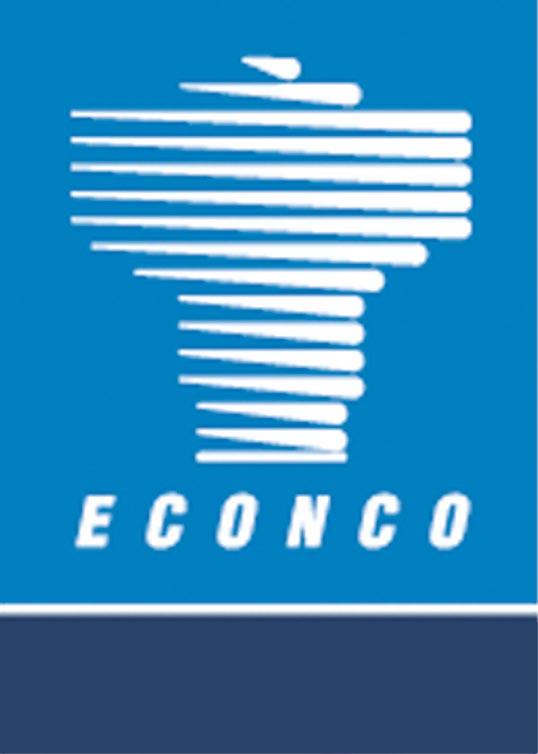

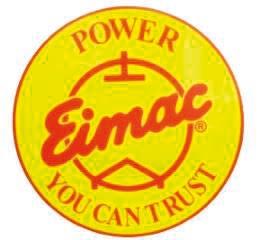
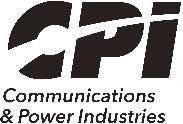
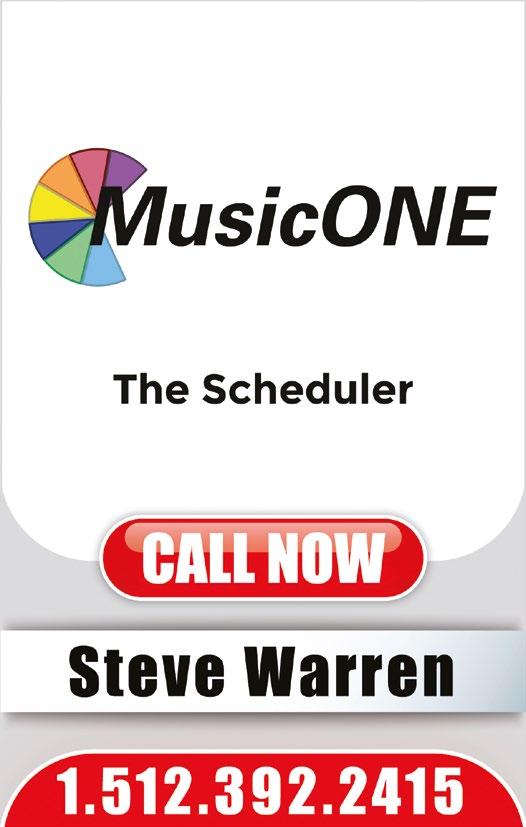

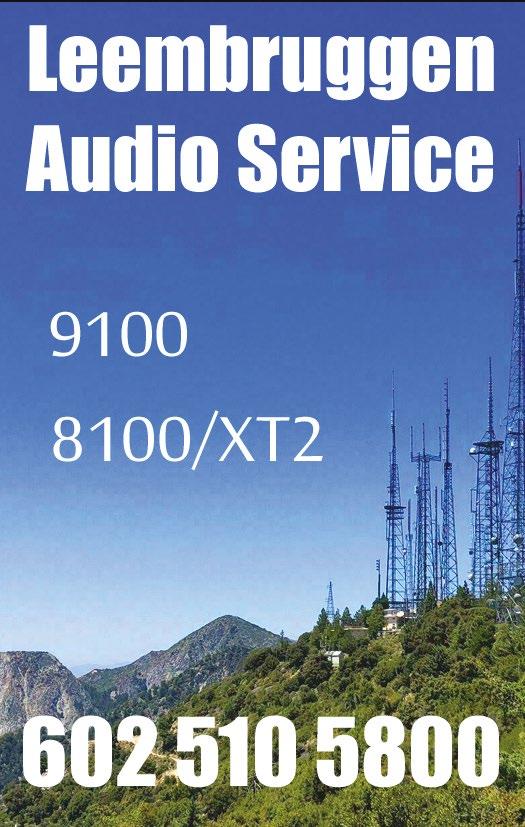
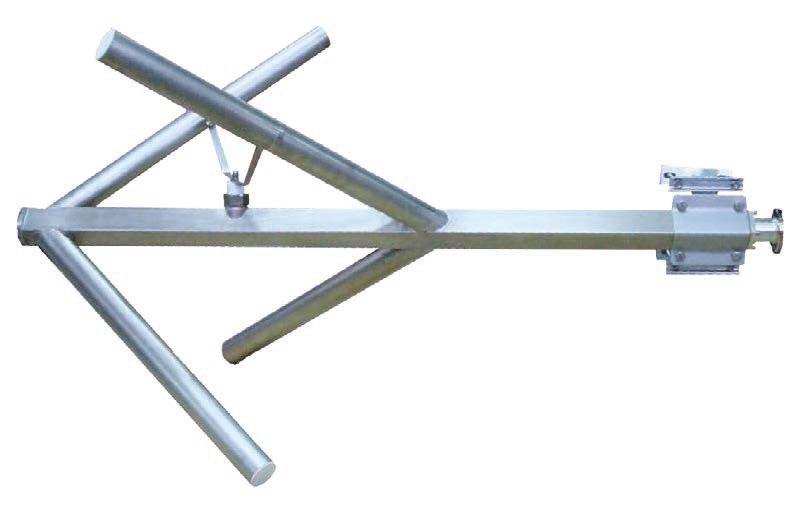
South Mountain project exemplifies a new approach
Vertical Bridge highlights the benefits of letting it do the work
Michael BelskiWith rising power costs, limited maintenance personnel and challenging technological and regulatory hurdles to navigate, broadcasters are looking to streamline their tower operations and are rethinking the need to own towers at all.
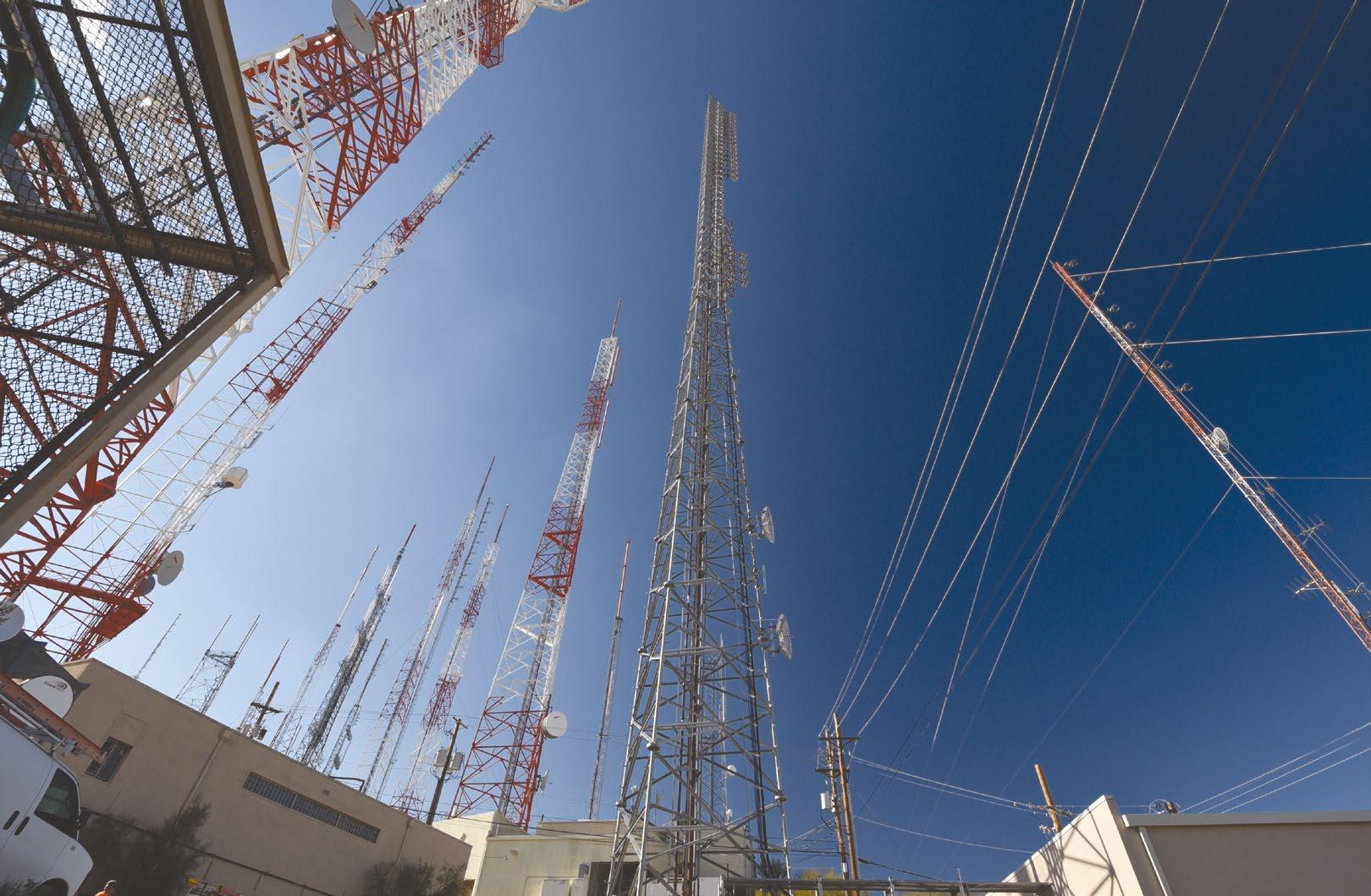
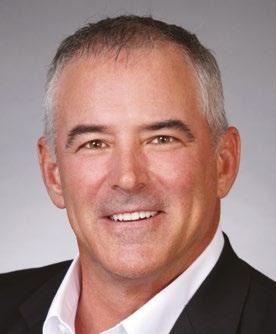
Vertical Bridge, the largest private owner and operator of communications infrastructure in the U.S., worked with perhaps the largest radio station broadcaster in history to provide a custom business solution in one of the most challenging markets. The project’s success is a model for other markets and broadcasters.
South Mountain
Below
The new tower is at center; its crowded RF environment is evident in this photo.
The antenna farm on South Mountain in Phoenix, Ariz., was established in 1955 when the Federal Communications Commission began to grant licenses for FM radio broadcast stations. The FCC identified South Mountain as an ideal location due to its high elevation and central location within the Phoenix metropolitan area. The 17-tower “farm” has grown to become one of the most recognized in the country.
Two and a half years ago, the owner of eight stations in Phoenix was broadcasting from three towers on South
Mountain. Today, with the help of Vertical Bridge, those towers have been removed and the company has been able to consolidate its operations into a single modern, energy efficient tower.
Working with Vertical Bridge, the broadcaster chose to lease space on this tower instead of continuing to own and operate the old ones. By removing the responsibility of servicing, renovating, engineering and maintaining the tower assets, Vertical Bridge enabled the company to free up working capital and do what they do best: focus entirely on growing their programming and advertising revenues.
Starting during a pandemic
The broadcaster and Vertical Bridge started the project in 2020 when the pandemic had taken a toll on the industry. Ad revenues were down, costs were increasing and trained personnel were scarce. A new solution was needed, and the companies came together to lay the groundwork for a new business model.
“Since COVID, everybody’s seen the change in the economy. We’ve seen inflation go up to 9-plus percent, which has strangled a lot of broadcasters,” said Gary Hess, vice president of broadcast and leasing for Vertical Bridge, adding, “A lot of broadcasting is talk radio. During COVID, without sporting events, they had nothing to talk about. For more than a year, that meant no advertising.”
Realizing it would be a difficult task with lots of moving parts, the big broadcast group chose to partner with Vertical Bridge, which had a reputation for moving nimbly and overcoming nearly impossible challenges. The broadcaster’s engineer met with Mark Stennett, director of broadcast engineering for Vertical Bridge, who mentioned that he would like Vertical Bridge to consider acquiring and replacing the tower pole that one of his stations was on because it was no longer structurally sound and unsafe to climb.
“The conversation was relayed to the broadcast leasing team and quickly grew from there,” said Stennett, adding, “It grew and evolved
through a couple of iterations before finally becoming what you see today.”
The project objectives were threefold: First, to consolidate the broadcaster’s stations onto one new tower. Second, to build and engineer the new tower. And third, remove the three old towers.
Working with municipalities
With over 16,000 acres of pristine nature and 58 miles of trails, South Mountain is beloved by the city of Phoenix and its residents. There were many ordinances and committees to coordinate and clear before the removal of the existing towers could be considered. In addition, those same ordinances, committees and many more federal mandates had to be considered before erecting a new structure. From radiofrequency considerations to structural/engineering guidelines and environmental preservation, there were ample legalities, policies and restrictions to work through.
“South Mountain is zoned by the city of Phoenix under the city’s parks and recreation department, which presents a challenging regulatory environment,” Hess said.
“With various lockdowns and government resources focused elsewhere in 2020 at the height of the pandemic, we faced considerable slowdowns.”
If that weren’t enough, at a critical time during the project, the city government had a complete changeover in leadership, meaning key relationships and processes had to be rebuilt. The Vertical Bridge team persevered and the project was completed in just two and half years.
Difficult spaces and terrain
One of the most difficult challenges in taking down the old towers and building the new one was the limited amount of space in which to maneuver.
“Everything was jam-packed in a small lot,” said Joe Meleski, Vertical Bridge vice president of broadcast leasing. “The access route was a winding pathway just big enough for three people to walk shoulder to shoulder. It was barely the width of a car, and we needed it to accommodate big cranes and trucks passing to and from the work site.”
To access the site with heavy equipment, Vertical Bridge widened the access road. Then after removing the old towers
How to submit
Radio World welcomes comment on all relevant topics. Email radioworld@ futurenet.com with “Letter to the Editor” in the subject field. Below Some of the RF transmission hardware is visible behind the site signage.

and the equipment on and around them, the area was much easier to work in and much safer for the RF engineers, technicians and tower climbers.
The new structure features a 16-bay ERI antenna with three auxiliary antennas. Five FM stations operated into an ERI combiner, which also has three open slots for possible future tenants. The site hosted a chapter meeting of the Society of Broadcast Engineers in December, from which the accompanying photos were taken.
Efficiencies gained
“We provided a modern solution to an age-old problem for broadcasters: How do you manage old towers as you continue to build new ones?” Meleski said.

This project brought several benefits for the environment, for the stations and for Vertical Bridge, the most noteworthy of which were operating efficiencies and environmental sustainability:
1. New, more energy efficient broadcasting equipment.
2. Reduced environmental footprint.
3. Less traffic on the mountain to maintain the tower site.
4. Shifted maintenance responsibility for five towers owned by the broadcasting conglomerate to a single modern tower owned and operated by Vertical Bridge.
“The new tower is pumping out a half a million watts right now as we speak,” Hess said. “It has room to get up to 800,000 watts on the main system and is much more efficient than its predecessors.” The broadcast client is the only tenant on the tower at present, but this is a multi-user facility that has additional capacity.
The success of the project in one of the densest antenna farms in the country is proof of a new business model where radio and television stations consolidate and upgrade towers by partnering with an experienced company that handles maintenance and operations. By working with broadcasters through their various unique challenges (e.g., pandemic, minuscule construction site, challenging regulatory regime, etc.) the Vertical Bridge team can deliver more efficient and longerlasting solutions for broadcasting companies.
Above ERI’s Bill Harland discusses the large FM combiner system with visitors.
